|
Australian Terrier International
Meeting The Needs Of Aussie Owners Globally
© 2010 Australian Terrier International
December 2011- Vol 1, Issue 1
|
|
|
|
|
|
Dear Friends, | |

As the end of 2011 approaches, we at ATI reflect on the wonderful year we had. We are blessed with a large membership of great people who love and deeply care not only for their Aussies but for all Aussies. This dedication to our chosen breed allows our members to share with each other, as well as with our Facebook group, all things "Aussie." By sharing photos for the newsletters or information for articles our members have helped us become a large and important voice for Australian Terriers. Each of our members has played an important role in shaping ATI.
We thank you for your generous hearts in reaching out to help others. We thank our Aussies for their love and generous spirits that keep us laughing and for bringing us all together.
We wish you a holiday season filled with love, laughter, good health and plenty of wet doggie kisses. We hope that 2012 will bring you peace, happiness and joy.
Your Friends From ATI
Pamela Levy
Editor
|
Featured Family | This month we are featuring the dogs of Gillian Bartlett of Australia. To see many of her beautiful dogs please click here. We hope you enjoy her interview that follows.
|
|
|
|
Congratulations Lifetime Member | ATI Congratulates Gillian Bartlett (Australia) on her Lifetime Membership. Gillian has worked hard to nurture and preserve our Grand Little Dogs. She has been a friend and mentor to many internationally. It was our great pleasure to welcome her to the US at the National Specialty in 2010. Gillian, ATI honors and appreciates your wonderful efforts and contributions.
_____
"I have known Gillian Bartlett for just over four years and in that time I have come to admire and respect her. She has been more than helpful in making my husband and I welcome members of the Australian Terrier Club of SA. She has also been helpful in encouraging me with the breeding of my Australian Terriers and in encouraging me to show my dogs as to which I have enjoyed and have some success. She has the Australian Terrier firm in her heart and is willing to help anyone if she can and is genuine in her efforts. I am honoured to call her a friend."
Cerrie Gower ____
What a delight for me to write a testimony about Gillian Bartlett. While I do not have the pleasure of knowing Gillian for several years as many other Australian Terrier folks do, I'm delighted to share a little bit about my experience with our friend and dedicated Australian Terrier person, Gillian Bartlett. When I was new to the breed, like most people I wanted to learn everything I could about the breed. Trying to locate information such as health, grooming, vaccinations, as well as the history of the breed from other experienced breeders, was not easy. At that time I did not meet the qualifications to join the Australian Terrier Club of America (ATCA). One of those requirements was that you must know two members of the club for more than two years. As I was new to the breed it was not possible for me to meet that requirement. Therefore, I needed to gather my information from other sources. I discovered the website for the Australian Terrier Club of South Australia. I contacted Gillian, who was the secretary, for assistance. She welcomed me with open arms. She sent me their handbook and provided me with the answers to my questions. Gillian was welcoming and kind to me, a person she had never met who was new to this wonderful breed. I was a welcomed member of their club immediately and have been ever since. I thank her for her dedication to Australian Terriers and congratulate her on this award of lifetime member from Australian Terrier International. Theresa A. Goiffon |
Congratulations To Lifetime Member - Gillian Bartlett (Australia) | |
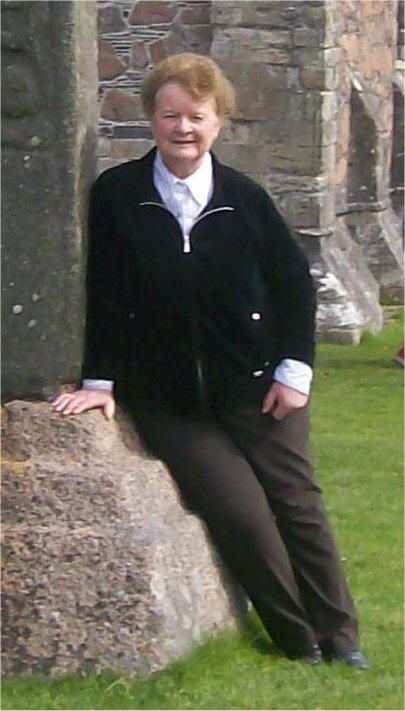
Gillian Bartlett
Did you have dogs as a child?
We had a well-loved Scottish Terrier called Heather. I admire the terrier temperament - loving, intelligent, no fool, spirited, who knows its own mind.
When did you become acquainted with Aussies and how did you become interested in showing?
In 1974, my young son David wanted a dog of his own, and the only puppy we could buy in Alice Springs, where we lived, was an Australian Terrier. We took the 8 week old puppy home and fell in love with him - Winton was the perfect dog. His parents were both Tineetown stock and he was very handsome. When we were on holidays a few years later we went to visit an Alice Springs friend who was showing his Old English Sheepdog at the show week in Canberra. We wandered over to see the Australian Terriers and thought that our dog was much better than those being shown. When we all were back in Alice Springs, our Old English Sheepdog friend helped me join the N.T. Canine Association, transfer pedigree papers, and enter a show. He showed me how to get up at 5am on the day of the show and shampoo and blow dry the dog's coat (no mention of any trimming, stripping or tidying). We entered the ring and the judge said "Oh no dear, see me afterwards." This kind lady gave me a quick lesson on how to strip a coat and groom the dog. At the show the next day we got our first Challenge Certificate, so her advice worked.

What other breeds have you owned?
My husband fell in love with a photo of a Norwich Terrier, and when we were on holidays in Melbourne in 1982 we visited a breeder who had the first Australian litter from English imports. The 8 month old Norwich wrapped himself around David and wouldn't let him go - we loved him, and he went back to Alice Springs with us. We imported a female from New Zealand 3 years later, but only had the one litter as the two didn't really like each other.
How many Aussies do you have currently living at your home?
Currently we have seven Australian Terriers - two geriatrics (13 and 15),
a de-sexed 8 year old female, a 5 year old stud dog, two 3 year old girls,
and a 10 month old female puppy.
What is it that you like about Aussies?
They are so handsome, easy to maintain and the right size dog to live with.
They have so much personality - loving, devious, intelligent, and appreciate anything you do for them.
Each Aussie has its own different character traits and is never boring - I can sit for hours watching them play, having adventures, trying to catch passing birds, anything that moves, or annoying each other.
How many years have you been involved with Aussies?
Our first Aussie arrived in January 1975. I started showing in 1980, bred the first litter in 1982.
You have been very involved with your club in Australia. Can you share with us the positions you've held?
When we came to Adelaide, South Australia, I was keen to see an Aussie breed club, and in 1997, with the support of a friend, we called a public meeting and got it under way. We did not have enough show people to have a big club so it was meant to be a club for ALL Australian Terrier owners or anyone interested in the breed. We currently have about 70 members. I was the secretary from the start until 2009. I have produced the club AUSSIE NEWS every two months since 1999 and am still currently the editor.
In your years with Aussies, how do you feel we are progressing or aren't we, with regard to health?
Care of pets has generally improved over the years, and hopefully with more information we are educating owners through breed publications.
In compiling the 'AT Database', I have been amazed at the past when some dams had so many litters, on consecutive seasons, and some even at 9 years of age. I think we are more conscious now that close matings are not desirable and that inbreeding causes problems. We are checking the health of our breeding dogs' ancestors, and having more humane breeding programs. It is good to see Australian Terrier clubs gathering information on the health of the breed. With regards to health, what more would you like to see, if anything, done? There is always room for more education of owners regarding diet, exercise, vaccinations and training, which all affect the dog's health. (I think everyone should attend a course and have a licence to prove competency to have a dog!)
How many litters have you bred?
I have bred 15 Australian Terrier litters. I would have liked to have bred more, but have been limited because of work commitments for many years. Later, I was limited for lack of suitable stud dogs or new lines available.
Do you feel the breeders in Australia are on the right course with their breeding programs?
Some are, some not. Some strive hard to keep an extended gene pool available by widening breeding lines even to bringing in interstate and overseas lines, maintaining a viable gene pool for the future.
In the past each Australian State has used mostly the same local gene pool and with a different emphasis on a type. South Australian Aussies were admired for the rough texture of their coats, with their rich tan and blue colour.
What if anything would you like to see more emphasis on with regard to breeding programs?
Personally I would like to see more use of 'outcross' dogs. This can import possible problems, but it would also breed a more standard type of dog. The top show dog is often used in preference to the dog not shown but may sire better progeny. Every breeder should know the Breed Standard thoroughly and strive to produce dogs that conform to the standard .
Our Canine Association Rules state that a bitch should not be bred from more than once in a 12 month period; I do not think the practice in some countries of having three consecutive litters is humane.
Have you imported dogs? Exported?
I would have loved to have had the female promised to me from the US (!!!!) but now I have a great little girl from New Zealand - Mystral's Bright N Breezy, who is doing well at the shows, and hopefully will contribute to the gene pool available when she produces puppies late next year.
I have exported a dog to Finland, and he has helped with the breed there by siring many litters.
How did you find those experiences and why?
Importing is complicated because of Australia's strict quarantine regulations. The New Zealand girl enjoyed her trip (aged 5 months) and was well looked after en route.
My male who travelled to Amsterdam/Helsinki at the age of 6 months was well cared for, with no problems and had a very excellent home in Finland.
It is hard to export and ensure the dog will have a good home, not just used in a breeding program and then sold, which is why I have not been too keen on sending dogs far away.
Have you made international friends as a result of those experiences? I have life-long friends in Finland. They have been so kind and loving to Jacko, and I don't think he could ever have had a better home. The breeder in New Zealand I knew and trusted; we are both proud of Breezy's success.
In 2010 you attended the US National Specialty. How would you compare the US dogs you saw to the Australian Aussies?
They are developing to their own style in the US. - all so immaculately groomed and well behaved. Our Breed Standard says: "Its untrimmed, harsh coat with definite ruff around the neck extending to the breastbone and its long strong head assist in developing its hard bitten, rugged appearance." In Australia, we know of the breed primarily as a family dog, more than a show dog. Of course, the dogs that are shown have been bathed, tidied (hair removed from in front of eyes, feet tidied, etc.) but not shaped and groomed to the extent that I saw on most of the dogs in the US in 2010. Many of the US dogs were a little larger, but we still have some variations here - some of the dogs range from 14 lbs. to 18 lbs., and may be 10 to 11½ inches at the withers.
Our judges like to have expression/fire in the dog, looking alert and interested in what is going on. Zeb's handler had him 'fired up' which I thought was great, showing he was alert and ready to go!
How has viewing the Aussie world through "international eyes" impacted your own breeding program?
Happy with what I am doing - getting outcross dogs, and knowing the ancestors in the lines I use. Handsome, healthy dogs with good temperaments have always been my aim.
What has been your high point in the breed?
Winning Best in Terrier Group four times at major all-breeds shows, and In Show several times with Canto and Bradman rate highly, but gaining obedience titles with Toby and Canto would rate higher. The ability to train a terrier/earth dog to act like a working dog takes time and tenacity and they both did me proud!
Have you had any favorite Aussies and why?
Canto, Toby, Della, Sappho, Trixie, Brad, Penny - where do I stop? Just love them all for being such beautiful dogs, good fun and company and enhancing our life.
What do you feel your contributions have been to the breed?
Preserving their history by establishing the "Australian Terrier Database" of pedigrees of Australian born Aussies (www.worldpedigrees.com);
being active in the formation of the Australian Terrier Club of South Australia,
and editing the AUSSIE NEWS for the club.
How would you like to be remembered in the breed?
As someone who was interested in maintaining the uniqueness of the breed, preserving its quality for the future and trying to improve each Aussie's quality of life.
|
International Partnerships
An Interview With Sue Holsinger (USA) and Krista Riihela (Finland)
| |
How did you both meet?
Sue: I was fortunate to travel to Finland in 2003 to the Finnish specialty. The day before I left we attended an all breed dog show. I met Krista there. She had a lovely puppy with her, and I would have liked to bring that puppy back to the US. It didn't work out for me to bring that puppy back, but we began corresponding via email.
Krista: Exactly as Sue stated.
How did you decide to import/export/ work together?
Sue & Krista: We both had an interest in broadening our breeding programs.

Reimin Meadows of Heaven. She has 2 CAC from shows. Sire CH Redwing Rhinestone Cowboy and dam Reimin Sweet Child O Mine. Owners Chrisse Asikainen and Krista Riihela (breeder)
What were the reasons you picked each other?
Sue: During that first year that we spoke via email, I learned that we shared breeding philosophies and liked the same type in Aussies. Krista has a good eye for a dog and is straightforward and honest. I liked that and felt I could trust her.
Krista:I really did like Sue`s Aussies that I had seen in pictures and I did feel that they could be very good for my breeding program as they have different strengths in their looks. I like the way Sue looks for an ideal Aussie and then I did feel that I can trust Sue.
Have you had other experiences working with people from other countries?
Sue: Yes, Sweden.
Krista: Yes, but not in the same way that I did with Sue.
How did those experiences work out?
Sue: It was fine, but I didn't develop the close friendship that I have with Krista.
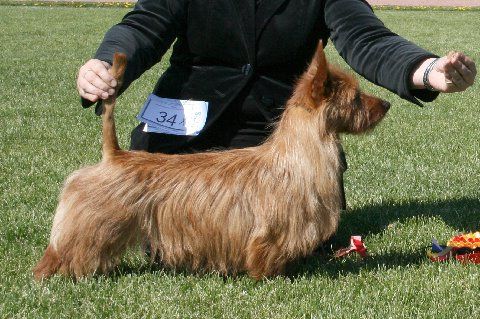
Photo Courtesy Of Sue Holsinger
Fin CH Redwing Mona Lisa Smile (Julia) Owned by Krista Riihela
What if anything did you learn from those experiences that helped you with your "partnership"?
Sue: People are the same worldwide. Once I realized that, I used the same criteria to evaluate potential international partnerships that I use for screening partnerships in this country. It helped me to put things in perspective.
How do you handle contracts between each other? Are they written, verbal?
Sue: I'm not sure we've ever had a written contract. Maybe at first, but that was a long time ago. Now everything is verbal. Krista is a very generous person and is easy to deal with. We both have the other's interests at heart.
What would you recommend others do if they are starting a new breeding "partnership" with someone in a different country?
Sue: Read the answer above. Trust your instincts. Ask the same questions you would ask someone in this country before entering into a puppy sale. Take your time to get to know the other person.
Krista: Try to get to know the person and her/his ideas of breeding. But I must say that you should very carefully trust your instincts.

Reimin Master of Puppets. He has 1 CAC and 2 reserve-CAC. Sire CH Redwing Rhinestone Cowboy and dam Reimin Sweet Child O Mine. Owners Mari Winqvist and Krista Riihela
How has working together changed your "eye," from a conformation standpoint or a health standpoint?
Sue: I think I'm more aware of traits that we're in danger of losing in this country because we tend to have different faults than they do in Finland. For example, many dogs in this country don't have enough shelf behind or enough rear angulation. I notice this when I see pictures of Krista's puppies, many of which have very strong rears.
Krista: Well, I have learned very much and I am very grateful to Sue for that. I have learned that American Aussies have much straighter front feet, smaller ears and they are much tighter built up. When I compare these things to Nordic Aussies, that are in some ways a little more stylish and maybe with more rear angulation, I think I do get a little closer to the Aussie that I have in my mind.
Have you noticed that dogs in other countries or from certain lines mature faster or slower than others? (I ask because I heard that dogs in Europe mature slower and that the European muzzle takes longer to reach its full growth.)
Sue: This is true. My dogs tend to mature very quickly and look adult at a year old. Krista's bloodlines take much longer. They typically wait until they're older to begin showing. The upside is that their dogs are still sound and lovely as veterans.
Krista: Yes, I think my bloodline takes quite a long time to mature and now that I have mixed with Sue`s breeding I have some Aussies that have matured more quickly; they have had nice results from puppy classes.
As life goes, sometimes we all have a rough patch. That could be with showing, health, etc. How does working together help you stay afloat during those times? Or does it?
Sue: Krista is a good friend. I know if I hit a rough patch that I can call her and bounce things off her and she will give me support and her honest ideas.
Krista: We can deal with a rough patch if and when they come. I trust Sue and I know that she is my friend and we can talk about everything.

Photo Courtesy of Krista Riihela
Fin CH Redwing Under Your Spell (Noita) Owned by Krista and Pihla Riihela
Sire CH Redwing Court Jester and dam Reimin Kiss Me
How do the logistics work? Do you ship the dogs or puppies? Do you fly with them? Is it expensive? What about vaccines and shipping times?
Sue: I have both flown with dogs and had them shipped. Either way it is expensive. There isn't a lot of difference between the two cost wise. The dogs seem to do fine either in cargo or under the seat. The regulations have changed recently, so now a third party shipper must be used to export from Finland. Vaccine requirements are standard with rabies after 12 weeks. I don't believe puppies under 12 weeks can be shipped.
Krista: I agree with Sue
How does tail docking vs. natural tails affect an American/European partnership?
Sue: Well, dogs can't be shown there docked. So I have left tails on puppies until we make the decision which ones will go to Finland. It is easier to dock one for show here than try to guess which will be the export puppy at 3 days of age. Pet people don't care whether their pets have tails or not, and once you have a tailed litter your eye quickly adjusts to that. Some overseas breeders have strong feelings about the natural tails and will not export a puppy if it's going to be docked. That's one of those things that need to be addressed well in advance.
Krista: I think that the Aussie itself is important, not the tail, so if it has a docked tail we can show only in those countries that allow it. I do not breed tails, only Aussies.

Photo Courtesy Of Sue Holsinger "Jekku"
Redwing Rhinestone Cowboy
When choosing a sire for a bitch, in the event of a disagreement with which dog to use who gets the final word?
Sue: That hasn't come up for us. Krista always asks my opinion, but I trust her judgment. It doesn't make sense for me to micromanage her breeding decisions when she knows more about the dogs there than I do.
Krista: I normally ask Sue for her thoughts about males that I am using and she says to trust your instincts and so I do.
Do you co-own all the dogs that are a result of your co-breeding program?
Sue & Krista: We don't co-own.

FI CH Reimin Spotlight Kid "Sulo". Sire CH Redwing Rhinestone Cowboy and
dam C.I.B Reimin No One Like You. Owner Anu Puotsaari
How do you choose what kennel names are given to each litter?
Sue: If I do the breeding, they are Redwing puppies; if she does they are Reimin, regardless of whether one comes back to live with me.
Krista: Sue breeds under Redwing and I breed under Reimin.
Do you use skype or how do you evaluate a litter together with both of you in different countries?
Sue: We use skype and evaluate by photograph.
Krista: We use skype and evaluate by photographs. I must say that when choosing a puppy I trust my feeling and instinct. I go with my heart and what it says. That may not be a very clever thing to do but sometimes it works. I many times choose the puppy that no one else does and Sue always tells me to trust that feeling and look how that puppy turns out.
Do you feel that you have improved the health of your lines by working with someone in a different country?
Sue: Yes. They tend to have different health issues there than we do.
I have benefited in so many ways from my association with Krista and my import/export experiences. I have a wider view of the breed (and the world) as a result. And I have a great friend in Krista.
Krista: Yes I do. I think we really do need new bloodlines for healthy Aussies.
I am so grateful for all Sue`s help and her trusting in me. Sue is a dear friend to me. These years of our partnership have given me so much. Sue has sent me beautiful Aussies and she has helped to make some of my dreams come true.
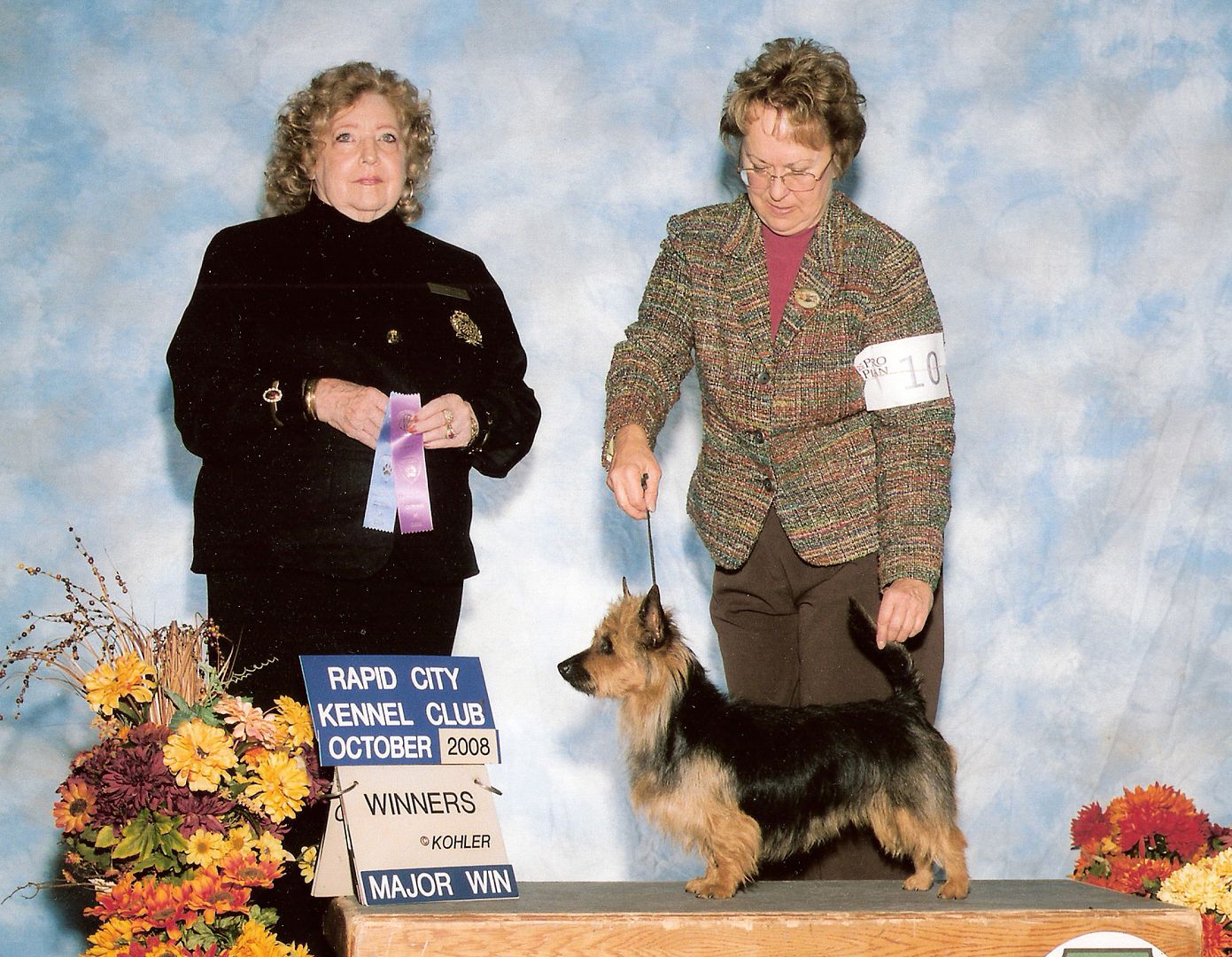
Photo Courtesy Of Sue Holsinger "Katie"

FI CH & EE JCH & NORDIC JUNIOR WINNER 2009 & ESTONIAN JUNIOR WINNER 2010 Reimin Seventh Sign "Stara". Stara was TOP BOS PUPPY 2009.
Sire CH Reimin Rhinestone Cowboy and dam C.I.B Reimin No One Like You. Owner Anne Nuutinen-Mäntylä

Reimin Dirty Dancing 10 months old. She received 2 CAC's at her first shows. Her sire is CH Reimin Air Force One and dam is CH Redwing Mona Lisa Smile. Owner Mrs. Anne Nuutinen-Mäntylä
|
Over The Rainbow Bridge
Reflections and Experiencing Loss by Pamela Levy |
 On September 7th, we experienced a tragedy of epic proportions. My husband had come down from a hike behind our home with "Emme" and "Alfie." It's a hike that we almost take daily. I was at dog camp in Stowe, VT with four of our dogs. Apparently "Alfie" did not go into the house with "Emme."
He chose instead to rest under the freshly washed car that sat outside the garage door. From that vantage point he could see his arch nemeses at play, the dreaded chipmunks, on our rock wall. Our caretaker moved the car into the garage and came into the house screaming with "Alfie" limp in his arms. He had not seen him resting under the car. He felt a sickening thump. The emergency vet said "Alfie" died instantly.
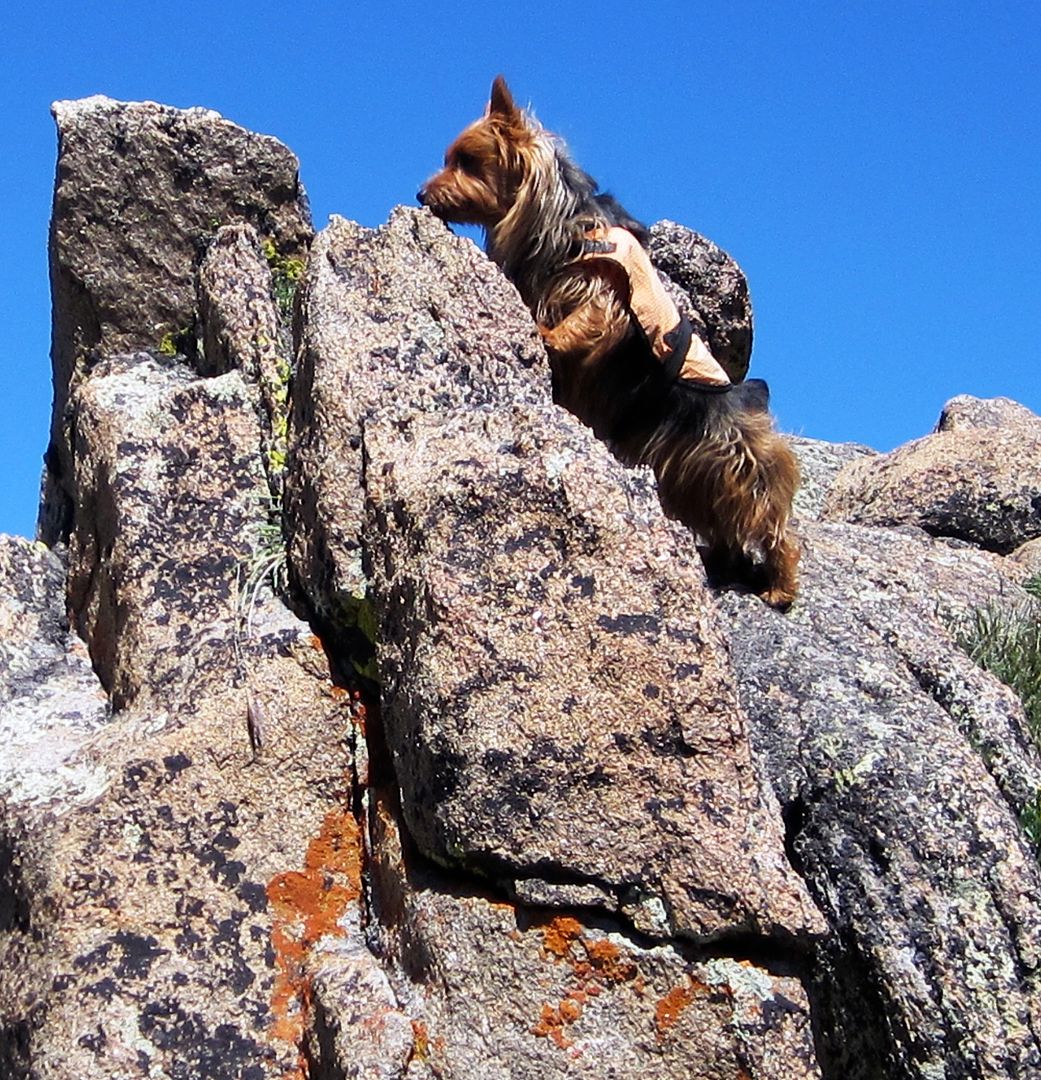 "Alfie's" first summit.
Campaigning dogs is an interesting activity. Instead of sharing experiences with people you are sharing many of them with your dog. At least that has been my experience. I can recall several horrible flights with "Alfie" be they delayed flights, sitting on the tarmac or turbulence. In each case he acted better than almost any child on any flight. Usually you never even knew he was on the flight. I remember returning to a hotel room when suddenly feral cats jumped out at us from under parked cars. We flattened ourselves against the hotel out of shock and fear. I remember the fun of building the partnership with "Alfie" and learning his idiosyncrasies. The worst of these was when he tapped the show lead with his nose; it meant give me the treat, NOW or I don't care if the Judge is looking I will jump straight into the air! I remember working in a hotel hallway with Gabriel Rangel at our National Specialty. We were practicing and Gabriel would say, "Take him down and back, faster, now slower, a little faster than that." We were trying to find his best pace and see for whom he was showing better. The work paid off and "Alfie" with Gabriel went Best of Breed at the National under Judge Dorothy MacDonald.
I remember my much-cherished owner handled National Specialty breed win with "Alfie" from Judge Sandra Goose Allen. I remember his Rose City breed win after he had been poisoned by antifreeze. The antifreeze had leaked out of a Waste Management garbage truck. My husband and I would drive back and forth in the middle of the night to the veterinary ER for his IV fluids. I remember how frightened I was that we would lose him and yet he bounced right back and took the breed three weeks later.
Flying to Mexico for the World Show was quite an experience. When he went breed and became the World Champion it was an amazing experience. The thrill was short lived as we showed at 8am and went back to the hotel to rest. The cab company called after an hour and told me to get right back down to get picked up to go back. "Alfie" and I ended up running through the streets to get back for the Groups with a traffic jam the likes of which I have never seen as a result of the show's popularity and importance in Mexico. "Alfie" and I looked at each other as if to say, "Who knew?" We kept running. We had so much fun.
 "Alfie" in the group ring at Westminster.
I remember how hard my husband and I worked to pull him out of the closet after he retired from the show ring, at four years old. If ever an Aussie loved the show ring it was "Alfie." I thought I was doing him a favor to let him enjoy a "normal" life at home. He didn't think so. Depression had gotten the best of him and he thought it was much better to sleep under my skirts for countless hours than to go outside and hike. We worked so hard to get his weight down.
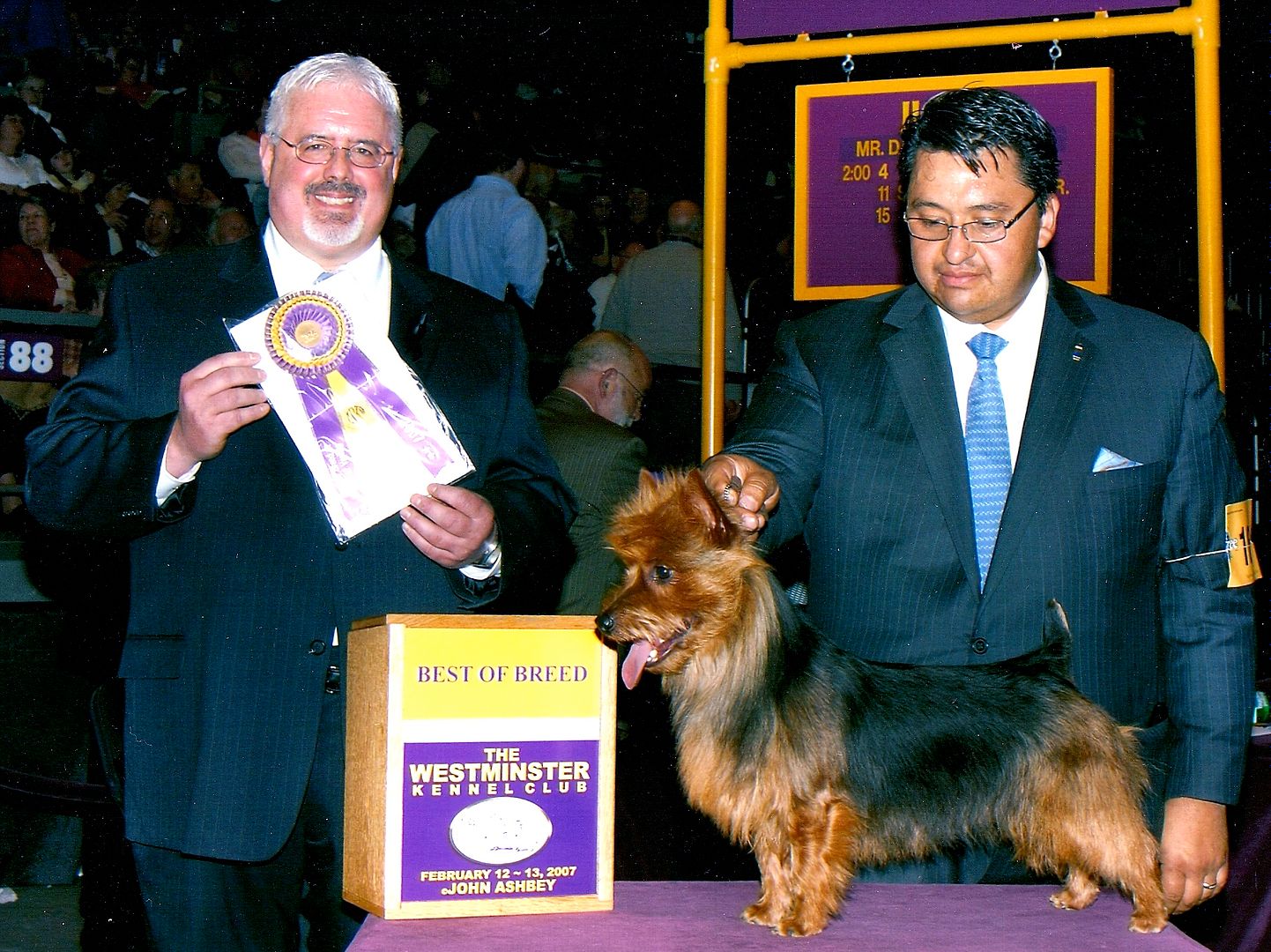 Judge David Kirkland, "Alfie" and Gabriel Rangel
I had this great plan for this year's National Specialty. "Alfie" and I were going to surprise Gabriel. Gabriel thought I was bringing my dog "Ringo" for him to show at our National Specialty. I wanted to surprise him with the lean, mean fighting machine; "Alfie." We weren't going with the hopes of winning; we were going to have a great time. I learned a long time ago, winning is great fun but it isn't everything. I never made it to the National at Montgomery. Quite frankly I could hardly put one foot in front of the other.
When your dog lives at home with you and you win the terrier group, it is not unusual to hear the word, "pet," uttered from less than happy handlers as you leave the ring. It always made me laugh. I usually was the first to say "Yes, just a pet" when "Alfie" would be honored with Group 1. Being Aussie owners we know our dogs want to live at home with us and most of them don't do well living with handlers or in kennel situations. When our Aussies are referred to as "pets" we accept it with pride. On the other hand, there was never a day that "Alfie" went into the ring that he didn't want that ribbon. I'll be the first to tell you he was not perfect in his conformation. There were things I would have loved to improve but it would never have been his attitude.
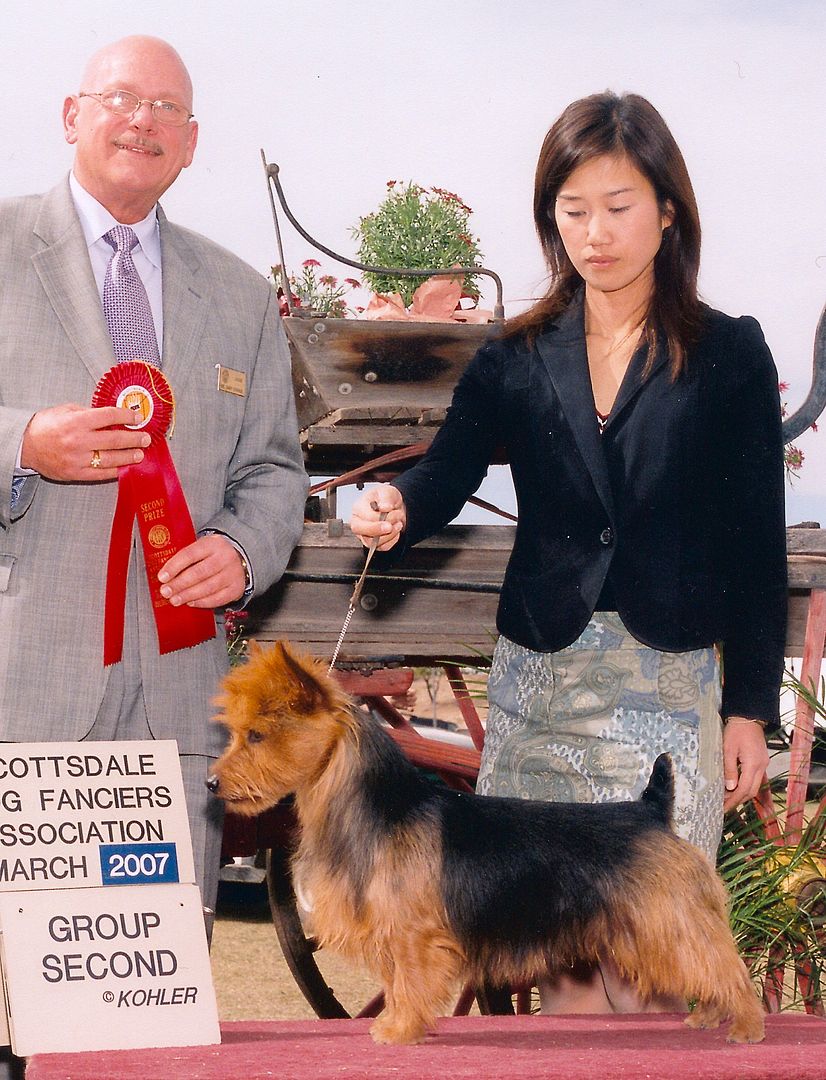 "Alfie" and his dear handler, Harumi Shiba of the Rangel team.
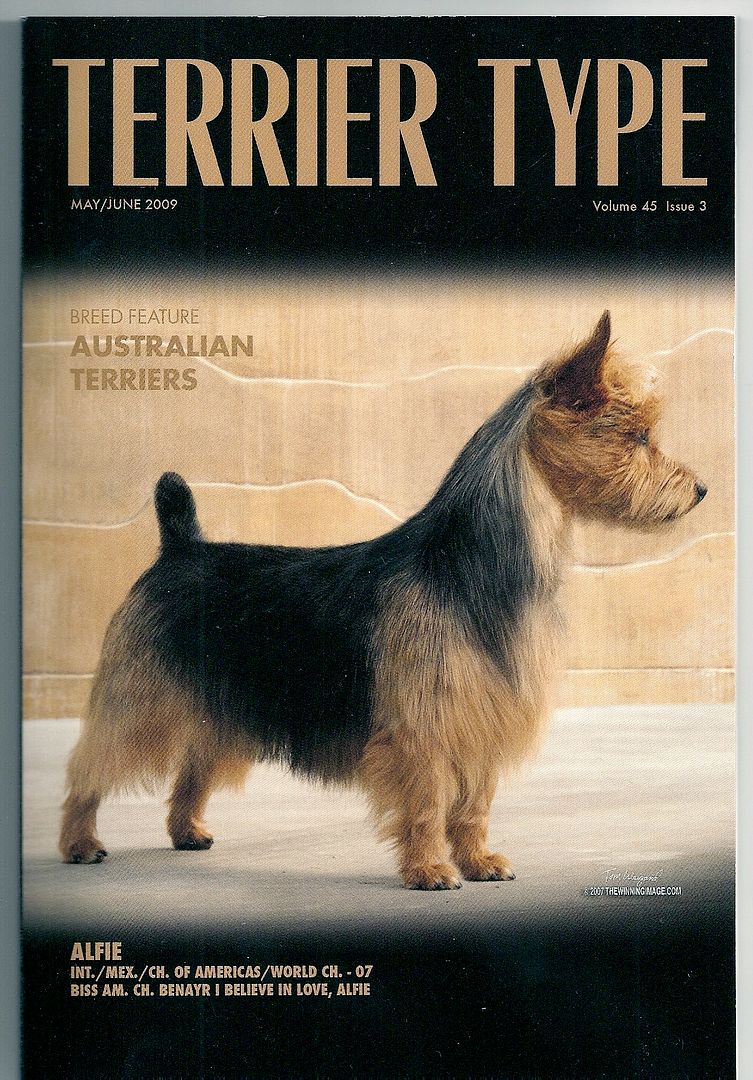 The second Aussie of just three to win the breed at the National (twice), Eukanuba and Westminster. He was the World Winner in 2007, an International Champion and Champion of the Americas. A few weeks ago I entered a dog show in Vancouver, WA with three of my dogs. We were the only Aussies entered. I just could not put the time into grooming the dogs, for emotional reasons. A detached part of me looked at each dog and thought, unfairly and embarrassingly, "You're no "Alfie." Finally on the day of the show I forced myself to get up at 6am and start grooming in a most determined way. I made it to the show. The judges that weekend were my angels. I actually walked in the ring with tears in my eyes. I think it was important for me to get back out there and to enjoy the camaraderie the dog show world offers. There are so many kind, concerned and loving people at the shows. Sometimes it can feel very competitive but it can also be very supportive. Having shared my life with "Alfie" has made my life richer, happier and wiser.  Soar with the eagles, our beloved boy. You were so loved and so very missed but you will never be forgotten.
To view "Alfie's" tribute video Click Here. |
Photos | |
Photo Courtesy Of Annelise Henning (Denmark) "Luka"
Photo Courtesy Of Annelise Henning (Denmark) "Luka"
Photo Courtesy Of Nancy White "Boo Boo"
Photo Courtesy of Nancy White "Boo Boo"
Photo Courtesy of Nancy White "Boo Boo"
Photo Courtesy Of Tracy Nelson "Kiwi"
|
Happy Holidays! Send Your Photos for The Holiday Edition Going Out On Dec 24th. |
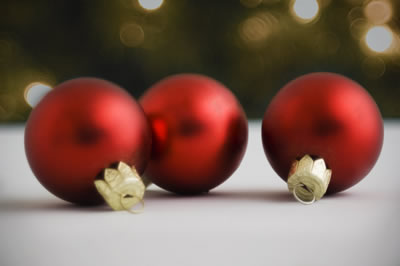 Don't forget to send us a photo of your dogs and your holiday wishes for the Don't forget to send us a photo of your dogs and your holiday wishes for the
ATI family. They will be included in the holiday edition.
Please send them by December 20th.
Email Your Photos To: AussieTerriers@aol.com
|
BIS BISS GCH Kambara's Zebulon by Anne Mitchell | My husband, Craig, and I have been showing and breeding Australian Terriers for ten years. We have been fortunate to have bred numerous champions and titled performance dogs.
Then we had a very special day, April 5, 2008, the day Zebulon was born.
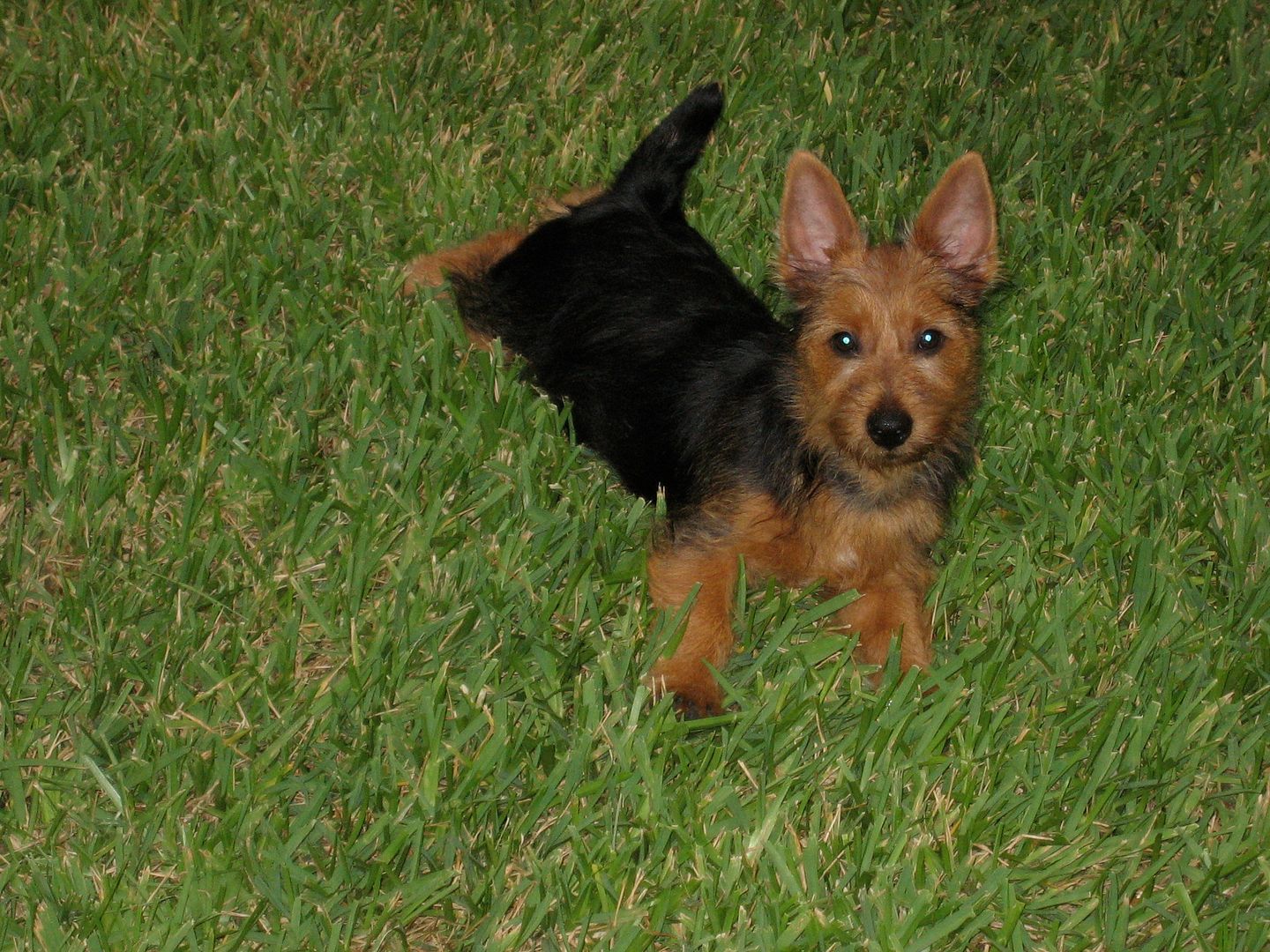 Young "Zeb" Young "Zeb"
We knew from the moment he was delivered that something was different. Zeb's dam, Hart, had a litter of five beautiful puppies, whelped between 8:30 and 11:30 pm. At 5:30 am Hart followed Craig down the driveway to get the newspaper. Halfway to the paper box, she yelped once, and Zebulon made his entry into "his world," the sixth puppy. Zebulon means God's precious gift and for us he has been a wonderful gift. While all of the puppies were nice, there was never any question for us about the one to keep. Zeb's littermate sister, Lil (Ch Kambara's Bella Macchina), went Best Of Breed (BOB) at Westminster Kennel Club, in 2010. But of the six puppies, it was always Zeb for us.
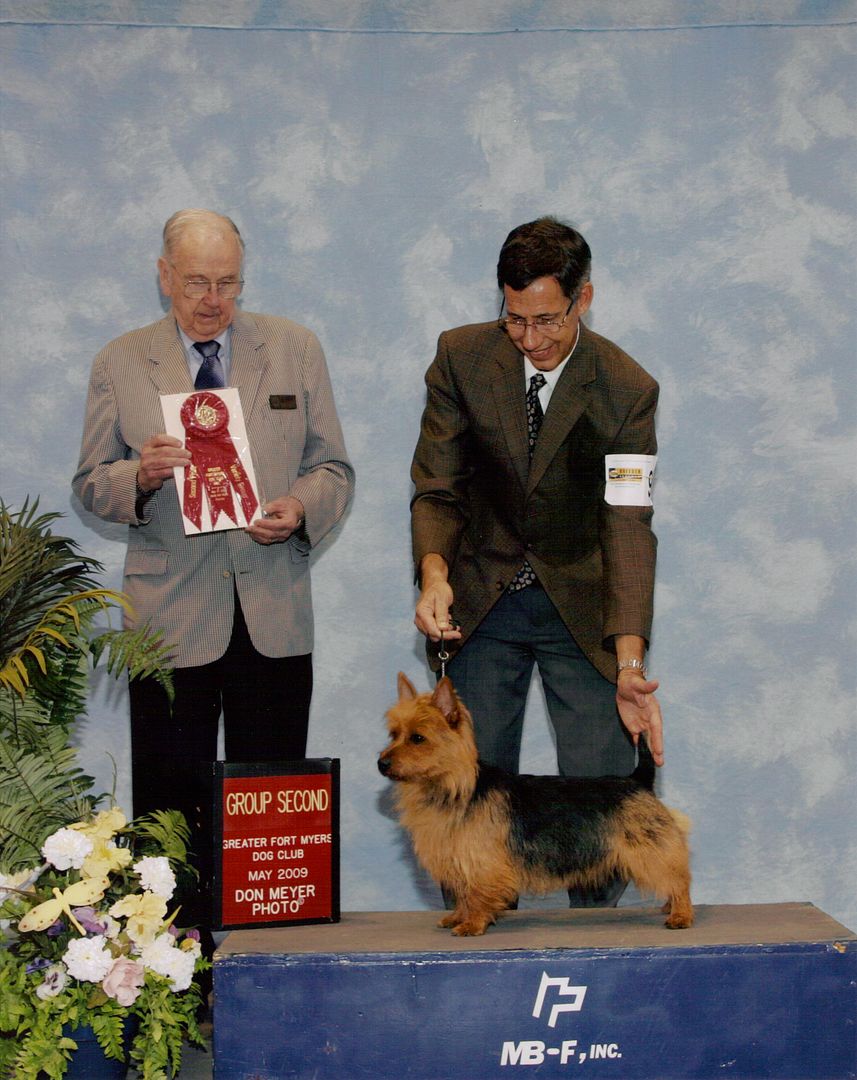 "Zeb" and Craig
Zeb finished his championship in February of 2009, shown by my husband, Craig, from the Bred by Exhibitor class. 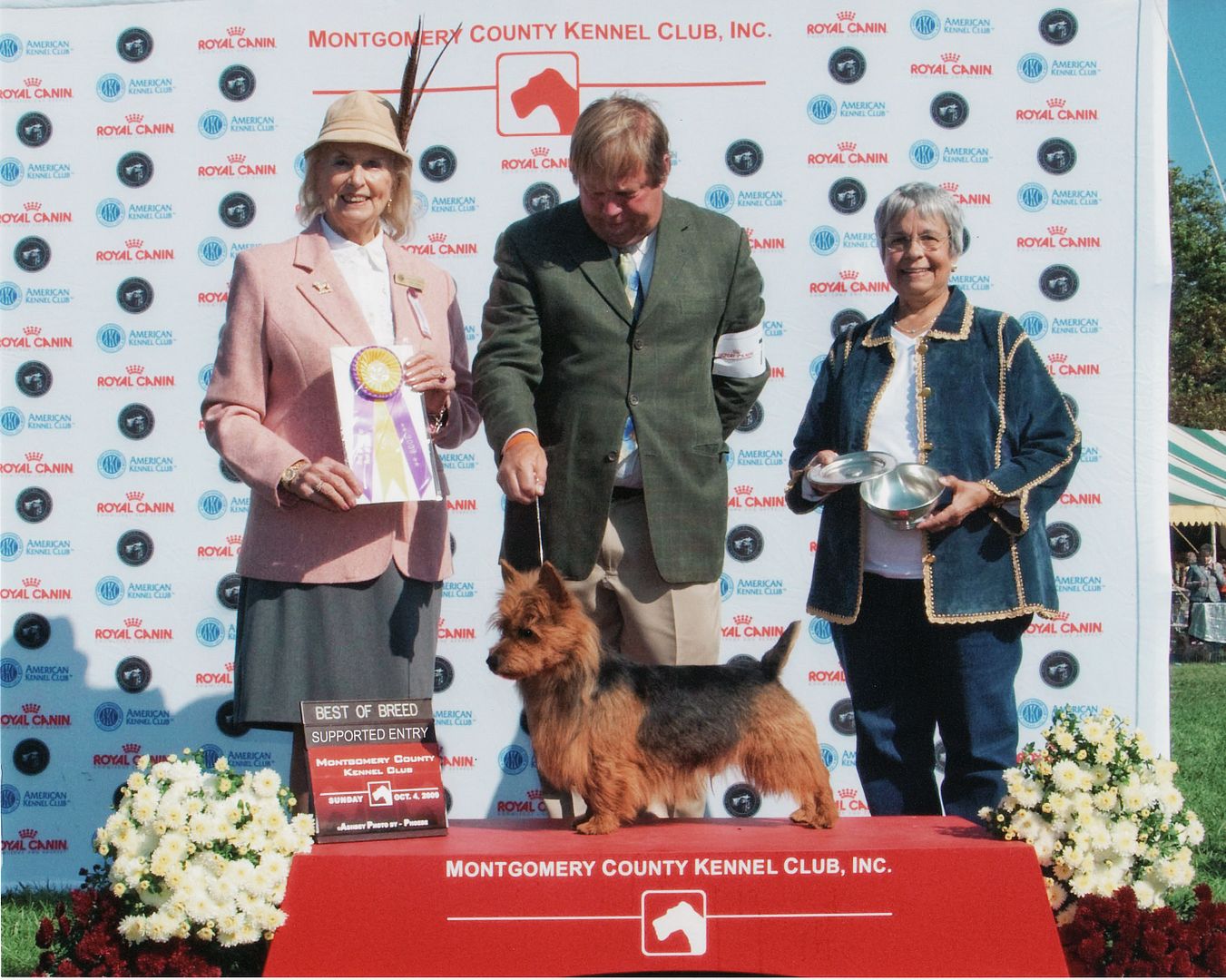 "Zeb" and Greg Myers "Zeb" and Greg MyersIn October of 2009, he went BOB at Montgomery County, shown by Greg Myers. We were in New York, watching "Lil" show in 2010, when Cathy and Dan Dahlberg approached us and asked if we were going to special Zeb and, if so, could their daughter Kellie handle him. Kellie had been a Junior handler with much success in terriers. We were not planning to special Zeb, but we said yes. Kellie Dahlberg became his handler.
When Zeb and Kellie won their first all-breed Best in Show on October 7, 2010, we were on a flight to Philadelphia. When we landed, Craig turned on his phone and asked me, "What does BIS mean, because there are so many congratulatory e-mails for Zeb's BIS." At that point, a whole planeload of people got to share our joy for our first Best in Show!
All five of Zeb's Best in Shows are so special and so unexpected. When asked, we just don't have a favorite, but one does stand out.
On the day of the National Specialty on October 22, 2010, Zeb won the Breed and went on to receive a Group 1. 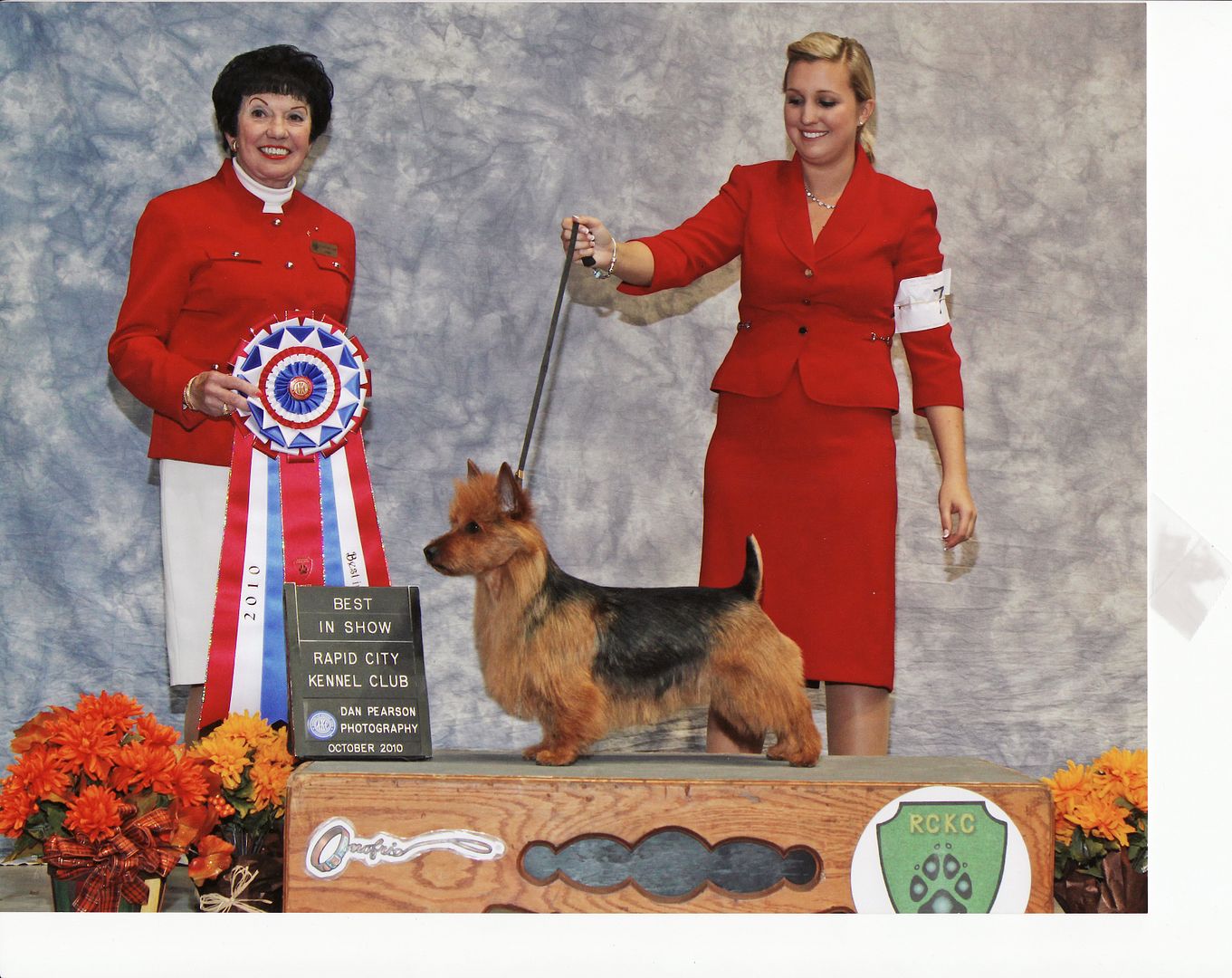 "Zeb and Kellie Dahlberg"
The next day Zeb won the breed again and once again he received a Group 1. Then with much support from the Aussie community we all watched with great excitement as Mrs. Barbara Alderman walked over to Kelly and Zeb with the Best in Show ribbon. That was Zeb's only Best in Show win that we have seen.
We feel Kellie Dahlberg is the perfect handler for Zeb. In our opinion, she is a groomer without equal and a polished professional in the ring. Most important to us is that Zeb loves to work with her. The results are almost magical. In less than two years, Kellie and Zeb have set many Australian Terrier records, including six Best in Shows, over thirty Group 1's, multiple specialty wins and multiple Bests in all-terrier shows.
Along the way Zeb has made many friends who love him almost as much as we do. He will have a less active show schedule in the future, but he will not be absent from the show ring.
We may or may not have another Best in Show winner, but since it was ten years since an Aussie received a Best In Show, we would like to think that Zeb has opened the door for all Australian Terriers to have this opportunity. "Zeb"
We know that the sons and daughters of Zebulon will carry his legacy into the future.
Zebulon and Kellie, thanks for a job well done; we are so proud of you!
Anne Mitchell |
Show History of Australian Terriers By Janet Maas - Akiba Australian Terriers |
The icon of Australian Terriers in the United States was Mrs. Milton Fox. She began her book The Australian Terrier with "Grand Little Dogs" as that is what she always called them. Originally considered one of the smallest of the working terriers, the Australian Terrier is ideally between 10 to 11 inches high at the withers, sturdy, with good bone, slightly longer than tall. They have a rough coat that comes in blue and tan, red and sandy.
Aussies are one of the best kept secrets in the dog world. In the 1800's newcomers to Australia required a dog to share their rugged lives. Because many stations in Australia were remote, the dogs developed strong bonds with their families. Very versatile, the Aussie could guard the family, control varmints, including snakes, work in the opal mines and even herd sheep. In the 1880's dogs known as "Rough Coated Terriers" or "Broken Coated Terriers" were shown in Australia. In 1873, the Broken Coated Terrier, which became the modern Australian Terrier, was exhibited at the Sydney Royal show in Australia.
It is not known exactly when the Australian Terrier arrived in the United States but it may have been as early as 1900. After World War I and II many soldiers returning to the states brought Aussies with them as there are references to them in the mid 1940's. Through the single minded determination of Mrs. Fox the breed was recognized by the AKC. In 1960 the breed was admitted into the stud books and the class at Westminster Kennel Club had a record entry of 58 dogs.
Perhaps the most influential kennels and the foundation of the breed in the United States are: Pleasant Pastures (1956), Regency (1963), Maiala (1961), Crestwood (1968) and Sprite Lea (1969). These names you will find in the pedigrees of today's dogs. Crestwood and Regency are still breeding today.
The first Australian Terrier dog to obtain his AKC championship was Cooees Straleon Aussie, in 1960; the first champion bitch was Sydnum Solitaire. Other achievements of note include the first dog to win an all breed Best In Show-
Ch Taralee Sekelutu, the first American bred Best In Show dog-Ch Sprite Lea Nevil V Knockland, the first Best In Show bitch was Ch Tineetown Talented, the first American bred Best In Show bitch was Ch Bearsteps Jowillie and the first red Australian Terrier to win a Best In Show was Ch Regency Lord of Summerville. Other Best in Show dogs were Ch Jeralen's Christopher Tobin, Ch Feathertop Riproarious, Ch Yaralla's Dunn Deal, Ch Crestwoods Song Of The South and her daughter Ch Vaneicha Singer's Aria. Another notable was Ch Yaralla's Rock The Ring who is the only Aussie to place second in the group at Westminster Kennel Club. He also placed in the group at Hatboro and Devon Kennel Clubs defeating over 1100 terriers at each show.  BIS Ch Regency Lord of Summerville - first Red BIS Aussie In 1971 Mrs. Fox imported one of the breed greats Ch Tineetown Talkback known to most Aussie folks simply as "Joey." Later that year, "Joey," handled by Charles Deer, won his first Terrier Group under Robert Graham. "Joey" eventually became known as an Australian, Canadian, Colombian, Bermudian, Mexican, International and AKC champion. In his show career in the US he obtained 29 group 1's and 54 other group placements. He won 4 All Breed Best In Shows, a record for that stood for 37 years! BIS BISS Ch Tineetown Talkback One of the most impressive records has come from Marge Regnier's Crestwood Kennels with multiple BIS BISS champions. They include Ch Crestwoods Crackerjack, multiple BIS Ch Crestwoods Jackson, BIS Ch Crestwoods Song Of The South and BIS Ch Crestwoods Contender "Cody". Crestwood dogs have not only been successful in the show ring but in the whelping box with Crackerjack being the top producing sire of all time and other Crestwood Aussies also being top producers. In 2000 Ch Crestwoods Contender started the decade by winning an all breed Best In Show.
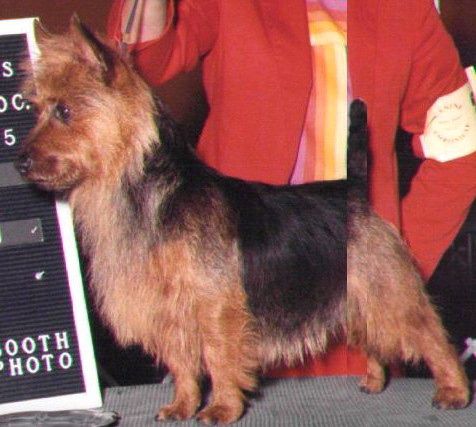 BIS BISS Ch Crestwoods Crackerjack Also competing successfully during this time was Ch Benayr Nessun Dorma owned by Pamela Levy. "Tucker" won breed at the National Specialty, Westminster and the AKC Eukanuba. Pamela followed with Ch Benayr I Believe In Love, Alfie. "Alfie" also won breed at the National Specialty, Westminster and the AKC Eukanuba. 
BISS Ch. Benayr Nessun Dorma 
BISS Ch Benayr I Believe In Love, Alfie Already well known and highly respected in Shetland Sheepdogs Susan Bentley brought her knowledge and expertise to the Australian Terriers. Her Benayr dogs have been some of the top winning dogs of the last 15 years, as well as, contributing to the bloodlines of dogs throughout the U.S. Long time breeders/exhibitors Sue Bachman and Teresa "Petie" Schreeder have had several successful dogs in the ring including Ch Ryba's Tom Foolery, Ch Ryba's Diamond Jim and Ch Ryba's Call Me Irresponsible. They joined with Susan Bentley breeding Ch Ryba's Batteries Not Included to Ch Benayr Raisa Ruckus, the duo produced 9 champions who were not only successful in the show ring but in the whelping box. Marilyn Harban, was successfully exhibiting her striking dogs Ch Dreamtime's Frontiersman and Ch Dreamtime's Dark Victory while Sue Holsinger's Redwing Aussies proved that reds could win big also with her Ch Redwing Court Jester and his dam Ch Redwing Comic Relief. 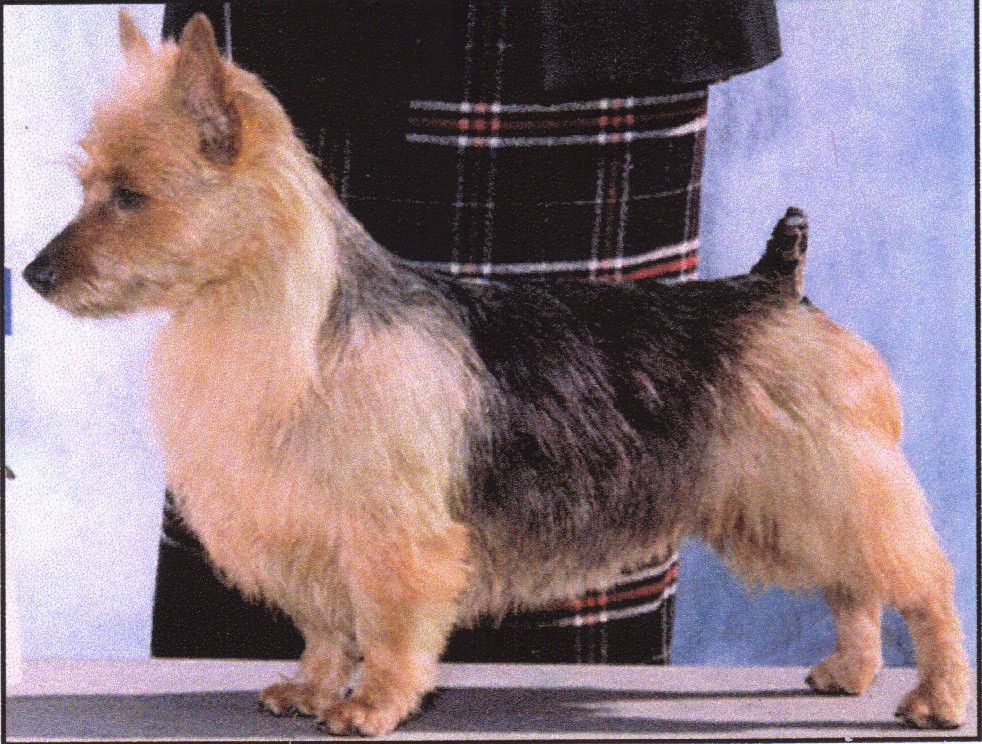
Ch Dreamtime's Frontiersman 
Ch Redwing Comic Relief Many of these dogs have not only been top show dogs but they have become top producers. Ranked in the top ten sires are the previously mentioned Ch Tineetown Talkback, Ch Jeralen's Christopher Tobin and Ch Taralee Sekelutu. Other top show dogs who became top producers are Ch Redberry Comrade, imported and owned by Ida Ellen Weinstock, Shelia Dunn's Ch The Farms Freestyle, and Ch Yaralla's Rock The Ring. Illustrating continuity many of these top dogs' offspring have become top show dogs and producers themselves. In 1998 Ch Tatongs Eclipse Of The Moon "Konsta" owned by Orvokki Lamsa and bred by Jill Greanne was imported from Finland to the United States. He made his mark by quickly finishing his AKC championship, winning an Award of Merit at both Westminster and the ATCA National Specialty and becoming a group winner and placer. Most importantly when "Konsta's" year long visit was up he left 8 champions behind. A "Konsta's" daughter produced a top show dog, Ch Akiba's Sixty Minute Man owned by Anne and Craig Mitchell. The Mitchells bred him to one of their bitches resulting in Ch Kambara's Zebulon "Zeb." In 2009, shortly after finishing his championship, "Zeb" won breed at Montgomery County under Australian Terrier breeder judge Lenore Riddle. But his specials career really began in 2010 when he became the breed's first Grand champion. He soon rocked the Aussie world, breaking a 10 year drought, by winning an all breed Best In Show. A few weeks later "Zeb" went on to prove this was not a fluke and won the ATCA National Specialty; the following day he won his second all breed Best In Show. In 2011 he broke "Joey's" 37 year record by winning his 5th Best In Show. To date he is the only Aussie to win breed at Montgomery County, Westminster, Eukanuba, the ATCA National Specialty, multiple Terrier Group Best In Shows and to date, six All Breed Best In Shows.  BIS BISS Ch Kambara's Zebulon With the legacy from our founding breeders and the dedication of current breeders hopefully Aussies have arrived and the dog show world will see more top winning Aussies in the ring and discover these "Grand Little Dogs". First Published in Showsight Magazine. |
"Reggie" The Earthdog By Heather Rife DVM
|
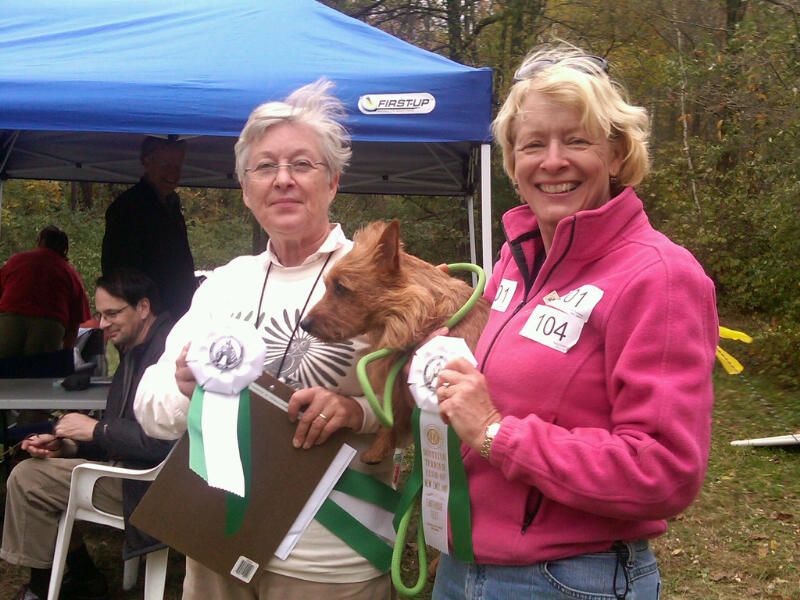 Photo Courtesy of Heather Rife DVM "Reggie" earning one of his Photo Courtesy of Heather Rife DVM "Reggie" earning one of his
endurance earthdog titles.
Reggie has earned his endurance earthdog title, the highest possible title in earthdog, and he is the first Aussie to earn it! He loves earthdog and earned the title in 5 consecutive trials, a 100% success rate.
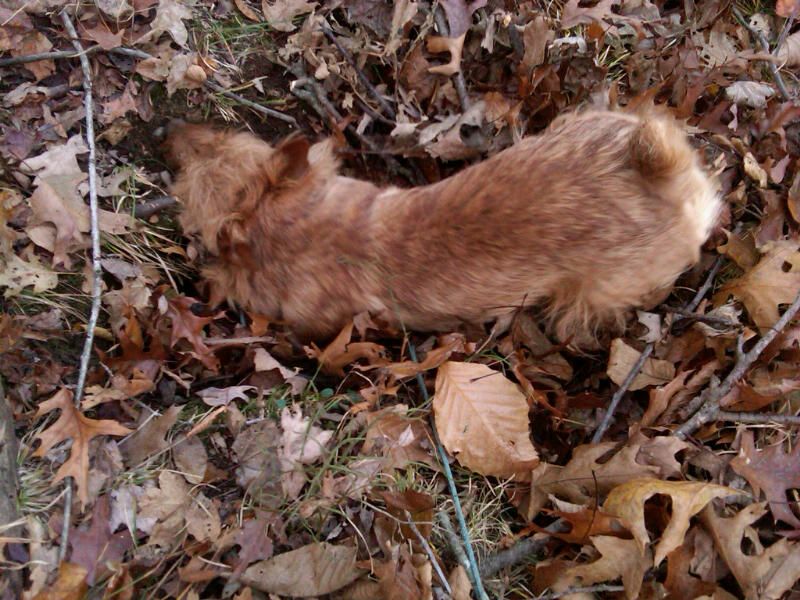 "Reggie" finding a den.
It is pitch black and cramped in the tunnel. The walls squeeze together and there is an obstacle that forces the dog to navigate either over or under it. The scent of rat is strong and wafts along throughout the tunnel. The dog follows the scent into a den area. There is nesting material but no animal. He continues to search for live quarry, twisting and turning through 40 feet of tunnel. Finally, a live rat, safely caged behind wooden dowels! The dog begins working, frantically barking and digging, trying to get to the rat. He works the rat for 90 seconds and then is lifted out by his owner. This is only one small part of the master earthdog test, part of the endurance earthdog legs that must be earned for the coveted title of Endurance Earthdog.
On November 5th, 2011, Reggie, aka GrCh Merrigang Wild N Crazy Guy, AX,AJ,ME , added Endurance Earthdog to his name. He is the first Australian Terrier to earn this title, the highest AKC earthdog title available. In order to achieve this title a dog must pass both a Master Earthdog test and a Senior Earthdog test in the same trial, and he must do it a total of 5 times to earn the title.
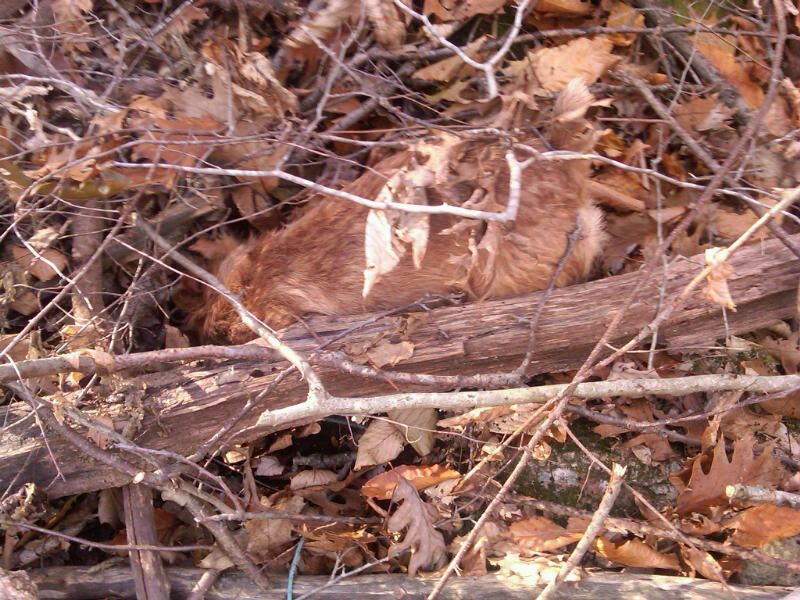 "Reggie" going after the animal. The Master test most closely mimics the natural hunting conditions a farmer and his dogs might have encountered long ago in the fields. Two dogs are randomly braced to hunt together. The dogs do not know each other and are expected to hunt off lead, without aggression or interference, with their handlers and the judge. The walk up, as it is called, wanders through fields or woods and encompasses several areas of scent lines the judge has laid using rat urine. There may be some freshly dug earth for the dogs to alert to, as well as any woodland animals in the fields or forests. The judge wants to see the dogs actively working the fields and hunting for quarry. The dogs must be under control and respond to the handler's directions. There is a false den, which is unscented. The handlers call the dogs over and each dog must clearly check the den and indicate to the handler that is empty. This requires control of the dogs, as handlers do not want both dogs to arrive at the false den together. The dogs continue to work the field until they reach a scent line which leads to a caged rat at the entrance to one of the tunnels. This is called "the mark" and each dog is required to indicate, through barking or digging, that live quarry is present. There should be a definitive difference in the dogs' behavior between the empty false den and live quarry. The dog may leave the mark to investigate other openings, but he is expected to come back to the opening that has the strongest scent. In an actual hunting scenario, the farmer needs to know which tunnel is active. Again, some control is necessary as the handlers don't want both dogs to arrive at the mark at the same time. After each dog "marks" the rat, they are picked up by the handlers and held while the rat is placed at the back of the tunnel. One dog is tied near the entrance while the other goes to ground. The "honoring" dog is expected to remain quiet above ground while the other dog searches the 40' tunnel, locates and works the rat. He then works the rat without cessation for 90 seconds. Any dog that leaves the quarry fails. After 90 seconds, the handler is then instructed to come and remove the dog from the tunnel within 15 seconds. The dogs are switched and the honoring dog gets to work the tunnel. The Master exercise tests the relationship of the dog and handler as a hunting team, one that is capable of working with other dogs and handlers without interference. Two intact males or bitches are expected to be able to work together, as would have happened on a farm in Australia in the 1800s. 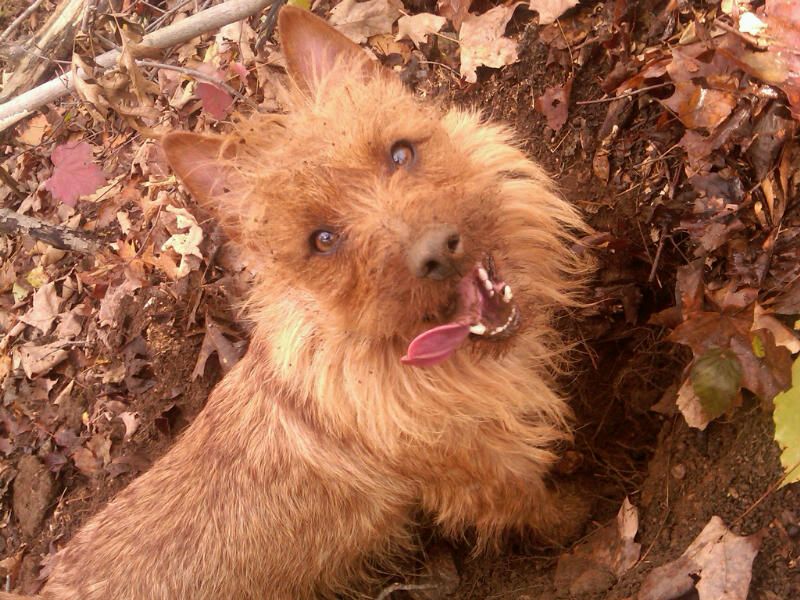 A very proud "Reggie." In the Senior test, the dog is released 20 feet from a well concealed tunnel entrance. He must locate the entrance, enter the tunnel, navigate the false den and false exit, find and begin to work the rat within 90 seconds. He must continue to work the rat for 90 seconds. The rat is then removed by the judge and the dog is recalled by the owner. He must stop working, back through the tunnel until he can turn around, exit the ground and be picked up by the owner within 90 seconds. This is more difficult than it sounds! Many dogs do not want to leave the tunnel only to be picked up by the owner and have the fun stop. In natural hunting conditions, this would simulate quarry bolting from the hole, and the dog returning to the farmer to continue hunting. A dog that continues to bark after the quarry has left is useless. The farmer would continue to dig wasting time and energy long after the quarry has left the area. It also tests handler control of the dog, an essential part of hunting. Many earthdog handlers feel this is the most difficult title to earn. 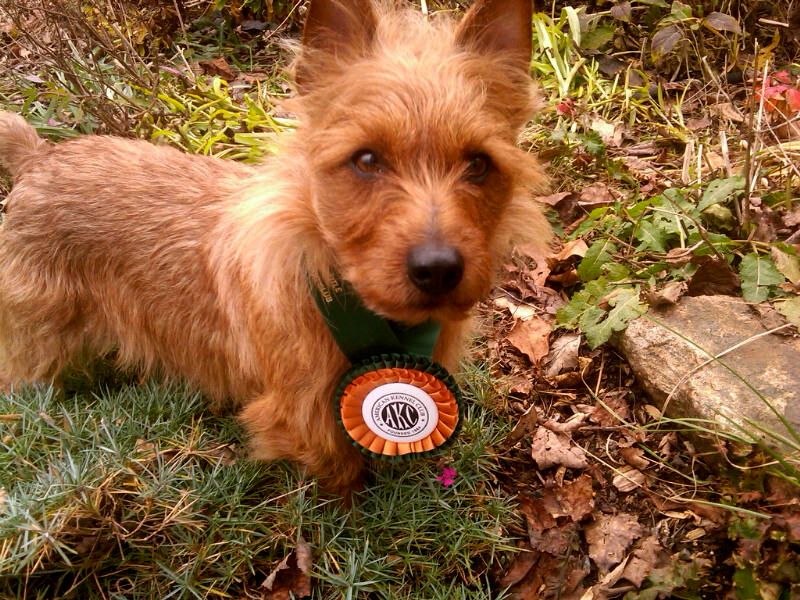
"Reggie" with his ribbon. In order to earn an Endurance Earthdog title, the dog and handler must pass both Master and Senior tests in the same trial, and pass a total of 5 times to complete the qualifications for the title. Reggie not only earned the EE title, but earned it in 5 consecutive trials! He will continue to compete in Earthdog, as he really showcases the versatility of our breed. The Aussie is not a common sight at an earthdog trial, and Reggie has shown that they really have the versatility to excel in the show ring and go to ground in the same weekend. I encourage you to try it with your Aussies. Earthdog competitors are very welcoming and will be happy to explain the tests to you. Your dogs will enjoy the hunt!
|
Education | Dr. Jerold Bell's Presentation Summary From the Breeders' Symposium Presented by AKC and AKC Canine Health Foundation by Theresa Goiffon.
Dr. Jerold Bell's entire presentation can be viewed by clicking here.
In November I attended an all day Breeders' Symposium at the University of Minnesota's veterinary school. The keynote speaker, Dr. Jerold Bell, was unable to attend, which was disappointing as he was my reason for attending. However, the material for his planned presentation was provided along with his permission to share his presentation with you in its entirety.
For those of you who are not familiar with Dr. Bell's work, he is a Clinical Associate Professor and Director of the Clinical Veterinary Genetics Course for the Tufts Cummings School of Veterinary Medicine. He is on the AKC Canine Health and Welfare Advisory Panel and the Board of Directors of the Orthopedic Foundation for Animals. He received his training in genetics and genetic counseling at Michigan State University and the University of Missouri. His DVM is from Cornell University. Dr. Bell is a lecturer to all-breed and individual breed dog clubs. He practices small animal medicine at Freshwater Veterinary Hospital in Enfield, CT.
In a previous ATI Newsletter, I included an article on Dr. Bell's work on what he calls the Popular Sire Syndrome (to view click here). I believe every breeder should read this article and understand the consequences of over use of a male, particularly in a small gene pool such as the Australian Terrier.
Dr. Bell's presentation covers:
* Pedigree analysis and how breeding decisions affect genes
* Common genetic disorders, diagnosis and counseling
* Improving the genetic health of your puppies
* Maneuvering the maze of genetic tests, interpretation and utilization
I find his work not only educational but very helpful to me as a breeder. He explains one method (Wright's coefficient) to measure average inbreeding and talks about line breeding and out breeding and its impact on your breeding program. He explains that there is no specific level or percentage of inbreeding that causes impaired health or vigor, which I found interesting.
Dr. Bell says that breeders should plan their matings based on selecting toward a breed standard, based on the ideal temperament, performance and conformation, and should select against the significant breed related health issues. Using progeny (Definition of PROGENY: descendants, offspring of animals and sib-based (Definition of SIB TEST: a test of the desirability of individuals as breeders based on the performance of their brothers or sisters and serving as an indirect test of prepotency compare progeny test ) information to select for desirable traits and against detrimental traits will allow greater control.
What I find difficult as a breeder is "really understanding" the dogs and their health, behind the pedigrees. Unless breeders have shared their history and this data openly, future generations of breeders will be unaware of what is truly in the background of their breeding program. For a new breeder this presents a challenge. My hope is that breeders will record their health findings and share that data with other breeders.
Dr. Bell notes that Australian Terriers are at risk for Legg-Calve-Perthes Disease. This is a genetic disease of small and toy breeds, where the blood supply to the hips collapses, causing bone degeneration and arthritis. Affected dogs can be identified usually between 4 months and 1 year of age.
The Australian Terrier is also identified, by Dr. Bell, as having a higher incidence in patellar luxation. The patella, or kneecap, is part of the stifle joint on the hind leg. Patellar luxation is a completely inherited disorder that causes the kneecap to pop out of its groove either medially or laterally. This causes pain and instability of the joint.
There are several inherited canine eye diseases. Dogs used for breeding should have eye screening examinations (CERF Exams) by a veterinary ophthalmologist. CERF eye examinations can usually be done inexpensively at CERF clinics conducted by dog clubs.
Hypothyroidism is another inherited disorder that is being monitored in the Australian Terrier. However, in Dr. Bell's presentation, he does not list our breed as one with high incidences of this disorder. In order to diagnose the disease, you have to identify the auto antibodies. A thyroid profile is usually done between the ages of 1 and 4. Most affected dogs will have clinical signs of the disease by 2 to 6 years of age. Interestingly, mixed breed dogs test 10.7% positive for thyroid auto antibodies. Please refer to Dr. Bell's article for more details.
As Dr. Bell points out, "It is the ethical responsibility and obligation of all breeders to perform the available required pre-breeding genetic health tests on prospective breeding stock." Most genetic tests only need to be done once in the breeding dog's lifetime. Other tests (eye exams, thyroid profile) should be repeated. He also states, "If you are not willing or able to have the prescribed pre-breeding genetic tests performed, then you should find a different hobby or profession. Dogs are living beings." I couldn't agree with him more!
|
Please Don't Feed Me That! by Theresa A. Goiffon | During this time of year of celebrations and gatherings, which usually include tasty treats, this is a reminder of what NOT to give our furry friends.
So, indulge yourself, but don't share everything with your dogs. Share a small piece of that turkey with them instead and review the list below from the Animal Poison Control Center.
Alcoholic Beverages: Any type of alcohol can be poisonous to your pet and aside from intoxication, can cause a coma or even death.
Apple Seeds: Can have varied effects on pets.
Apricot Pits: Can cause respiratory difficulties such as breathing, coughing and sneezing.
Avocado: The leaves, fruit, seeds and bark of avocados contain Persin, which can cause vomiting and diarrhea in dogs. Birds and rodents are especially sensitive to avocado poisoning and can develop congestion, difficulty breathing and fluid accumulation around the heart. Some ingestions may even be fatal.
Cherry Pits: Can cause respiratory difficulties such as breathing, coughing and sneezing.
Candy containing the sweetener Xylitol: Can cause liver damage and even death.
Chocolate: Although pets should never have any type of chocolate, milk chocolate is not nearly as dangerous for animals as semi-sweet or unsweetened bakers chocolate. Chocolate poisoning can cause irregular heart rate and rhythm, restlessness, hyperactivity, diarrhea, vomiting, panting, muscle tremors, abdominal pain, bloody urine, increased body temperature, seizures, coma and possibly even death.
Coffee: Can result in increased breathing and heart rate, restlessness and affects the central nervous system.
Grapes: Large amounts of grapes can be poisonous to pets and can cause vomiting, diarrhea, lethargy, abdominal pain, lack of appetite and kidney damage.
Hops: May cause panting, elevated temperature, increased heart rate, seizures and possibly death.
Macadamia Nuts: Can cause vomiting, lethargy, hyperthermia, abdominal pain, stiff joints, lameness and tremors.
Moldy Foods: Can have varied effects on pets including vomiting and diarrhea.
Mushrooms: Different types of mushrooms can have varied effects on pets such as, depression, diarrhea, nausea and vomiting, abdominal pain, tearing, hallucinations, defecation, liver failure, seizures, drooling, urination, kidney failure, heart damage, hyperactivity and in some cases, death.
Mustard Seeds: Can have varied effects on pets.
Onions and Onion Powder: Can cause gastrointestinal problems such as vomiting and diarrhea.
Peach Pits: Can cause respiratory difficulties such as breathing, coughing and sneezing.
Potato Leaves and Stems: Can cause problems with the digestive, nervous and urinary systems.
Raisins: Large amounts of raisins can be poisonous to pets and can cause vomiting, diarrhea, lethargy, abdominal pain, lack of appetite and kidney damage.
Rhubarb Leaves: Can cause problems with the digestive, nervous and urinary systems.
Salt: In large quantities can cause electrolyte imbalances.
Tea: Can have varied effects in pets.
Tomato Leaves and Stems: Can cause problems with the digestive, nervous and urinary systems.
Walnuts: Can cause gastrointestinal problems such as vomiting and diarrhea, as well as respiratory issues such as sneezing, breathing and coughing.
Yeast Dough: Can be dangerous as it will expand and result in gas, pain and possible rupture of the stomach or intestines. NOTE: If you suspect that your pet has been poisoned, contact the American Society for the Prevention of Cruelty to Animals (ASPCA) Poison Control Center at 1-888-426-4435. This is a 24 hour a day hotline. Recalls: Recently, there have been recalls of dog food or treat products. To see the most current information regarding recalls as well as contact information should you need to report a possible contamination visit the ASPCA at this link
http://www.aspca.org/Home/Pet-care/pet-food-recall-overview.aspx Poinsettia Toxicity: Toxic to dogs Toxic Principles: Irritant Sap Clinical Signs: Irritating to the mouth and stomach, sometimes causing vomiting, but generally over-rated in toxicity. ATI suggests you always check with your veterinarian before changing foods. |
Food Recall | December 6, 2011
P&G VOLUNTARILY RECALLS ONE PRODUCTION LOT OF DRY DOG FOOD
CINCINNATI, OH December 6, 2011 - The Procter & Gamble Company (P&G) has voluntarily
retrieved a single production lot of dry dog food due to aflatoxin levels that were detected above the
acceptable limit. This product has already been retrieved from store shelves. No illnesses have been
reported in association with this production lot to date, and no other Iams pet food products are involved.
Product affected by this announcement:
Iams ProActive Health Smart Puppy dry dog food
with Use By or Expiration Dates of February 5 or February 6, 2013
7.0 lb bag 12784177I6 1901402305
8.0 lb bag 12794177D2 12794177D3 1901410208
17.5 lb bag 12794177K1 12794177K2 1901401848
The affected product lot was distributed to a limited number of retailers located in the eastern United States (AL, CT, DE, FL, GA, LA, MD, ME, MS, NC, NH, NJ, NY, PA, SC, VA). These retailers have already removed this product from store shelves. No other dry dog food, dry cat food, dog or cat canned food, biscuits/treats or supplements are affected by this announcement.
While no health effects related to this product have been reported, P&G retrieved this product as a precautionary measure. Consumers who purchased the product listed should stop using the product and discard it and contact Iams at the number below for a replacement voucher. Aflatoxin is a naturally occurring by-product from the growth of Aspergillus flavus and can be harmful to pets if consumed in
significant quantities. Pets which have consumed this product and exhibit symptoms of illness including sluggishness or lethargy combined with a reluctance to eat, vomiting, yellowish tint to the eyes or gums, or diarrhea should be seen by a veterinarian.
For further information or a product replacement or refund contact P&G toll-free at 866-908-1569 (Monday - Friday, 9:00 AM to 6:00 PM EST) or www.iams.com.
_______________________________________________________________
Cargill has announced a voluntary dog food recall involving two of its brands due to contamination with aflatoxin. Both River Run and Marksman dry dog foods were produced at Cargill's Lecompte, Louisiana plant. The recall includes 13 states and 2 territories: Kansas, Missouri, Northeast Oklahoma, Arkansas, Louisiana, Mississippi, Tennessee, Western Kentucky, Southeast Indiana, Southern Illinois, Hawaii, and limited areas of Florida, California Guam, and the Virgin Islands. The FDA has confirmed the Cargill recall in its latest news bulletin. Aflatoxin is a toxin produced by a certain species of mold commonly found in cereal grains. The products listed have Lot Codes 4K0335 through 4K0365, 4K1001 through 4K1335, LL0335 through LL0365, and LL1001 through LL1335 on the tag or bag and include: - River Run Professional Formula 27-18 Dog Food 50#
- River Run 21% Protein Dog Food (50# and 40#)
- River Run Hi-NRG 24-20 Dog Food 50#
- River Run Hi-Pro No-Soy Dog Food (50# and 40#)
- Marksman 28-18 Dog Food 40#
- Marksman 24-20 Dog Food 40#
- Marksman 20-10 Dog Food (50# and 40#)
What to Watch For According to Cargill... "Exposure to excessive levels of aflatoxin, especially over extended periods of time, can lead to reduced liver function. Call your veterinarian if your dog has had a product that may have contained aflatoxin and exhibits sluggishness or lethargy combined with a reluctance to eat, vomiting, diarrhea, or yellowing of the eyes or gums."
What to Do If a dog shows any of these signs, consumers should stop feeding the suspected products immediately - and consult a veterinarian. You can report complaints about FDA-regulated pet food products by calling the consumer complaint coordinator in your area. Or go to http://www.fda.gov/petfoodcomplaints. Cargill has suggested consumers return any unused portion of the recalled dog food to the store where it was bought for a full refund. For more information, call the company at 855-460-1532.
|
Make Your Own Aussie Postage Stamps | This holiday season why not mail your holiday cards with a photo of your very own Aussie.
For a sheet of 20 - $.44 first class stamps featuring your own dog,
they have a special rate Of $14.95 which will cost about 75 cents per stamp.
Make Your Dog A Star!!!
|
The Dogs Of Ewa Karllson
|
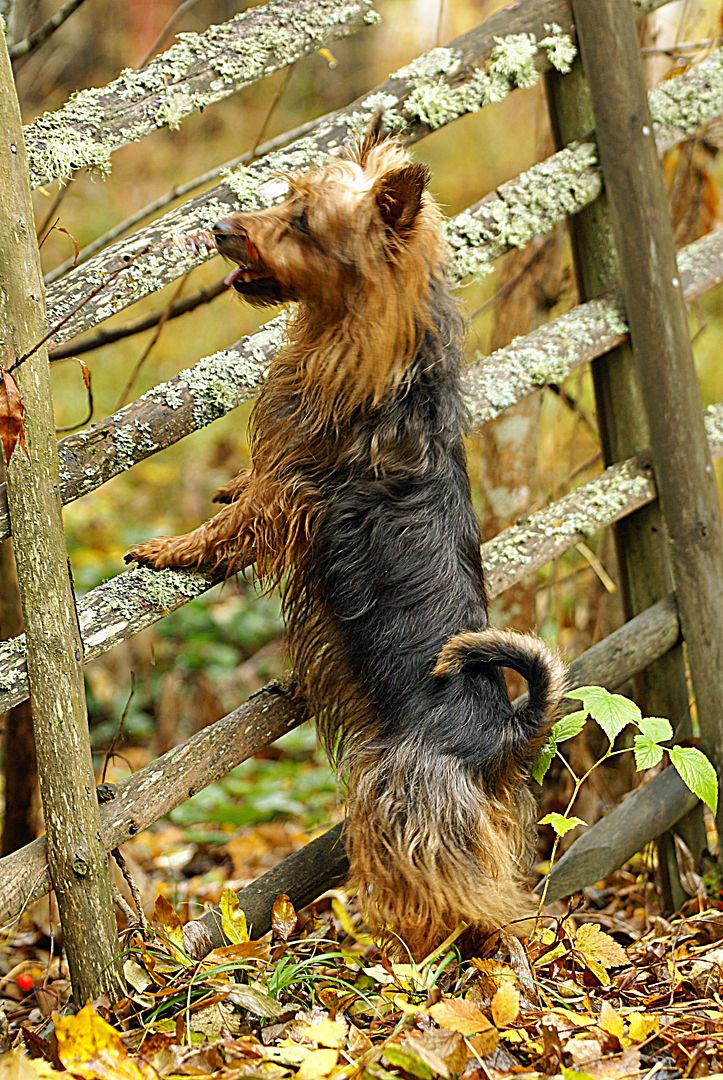 Alhammarens Hera "Maja" Photography by Anette Andersson 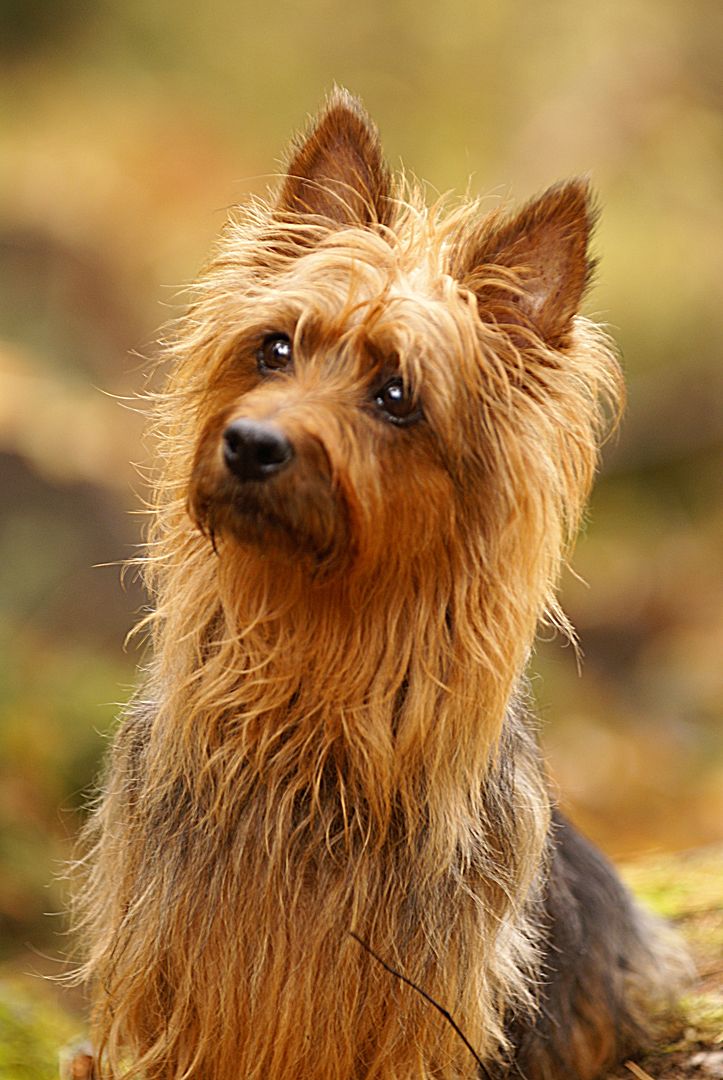 Alhammarens Hera "Maja" Photography by Anette Andersson 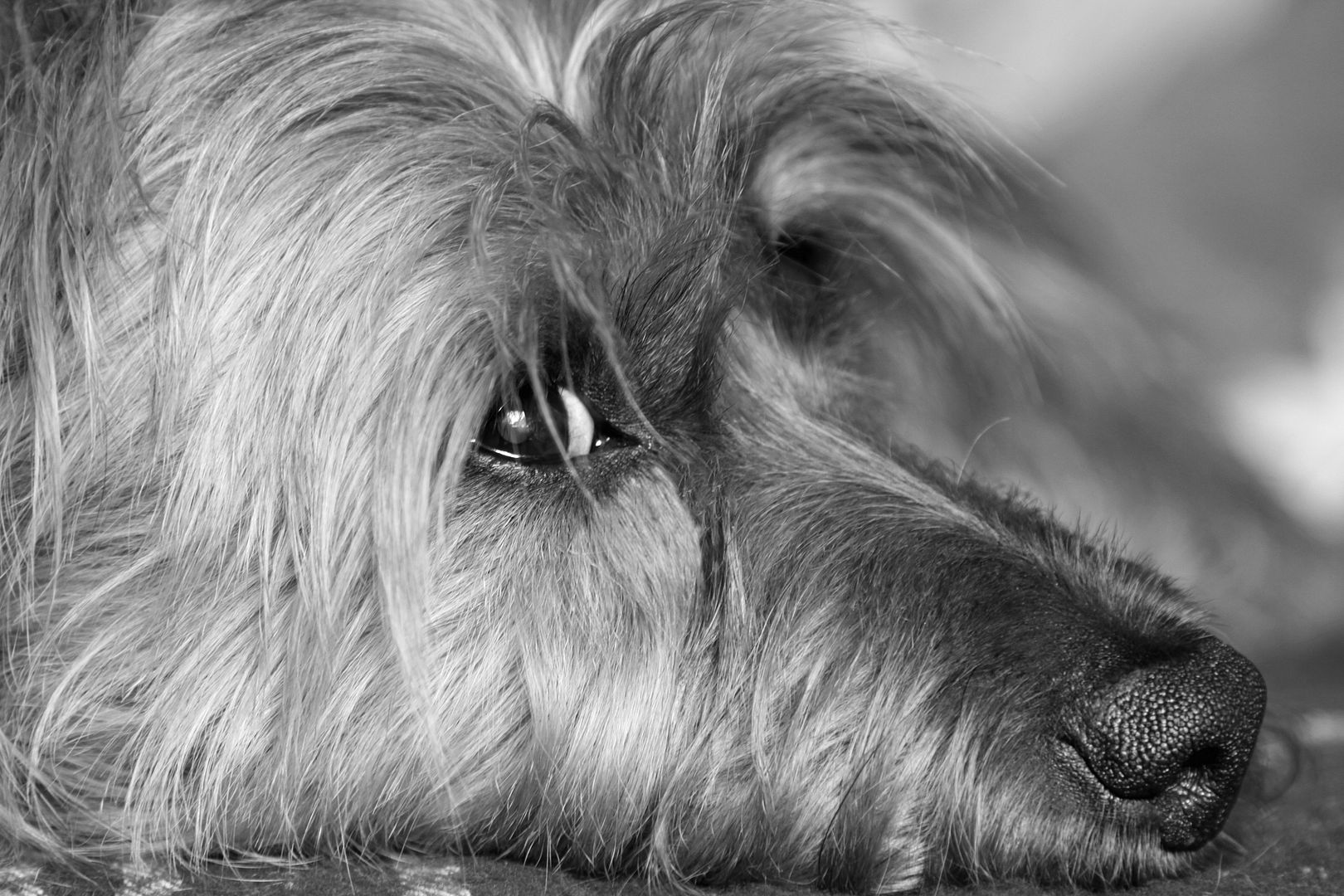 Pariservikens Confidence "Texas" Bred by Ewa Karllson Photographed and Owned by Anette Andersson  Summer Fun Photographed by Anette Andersson  More Summer Fun Photographed by Anette Andersson
|
New Item
| The Aussie Market will now carry the Cuz Ball and other durable toys from JW Pets. Click here for all available items. Cuz balls can not ship before December 21st.
Good Other Cuz & Bad Other Cuz
When they created the Other Cuz they gave it a personality all its own: expressive eyes, cute little legs but no feet. Plus an ingenious squeaker that's designed so it won't fall out. Don't let that sweet disposition fool you. The Other Cuz is tough and durable.
|
Warnings | At times we want to share information that one of us may have learned the hard way. This comes from a member who wants to keep your dogs out of harm's way.
WARNING: At NO time use Comfortis (for fleas) and Ivermectin together.
It can be DEADLY to your pet. These two chemicals do NOT go together.
Seizures in Aussies have been reported when using these two products together.
|
Juniors-AKC Stats | |
Top Australian Terrier Junior Handlers in the US through September 30, 2011
Christina Worley 118
Samantha Gray 110
Eleanor Goiffon 27
Lydia Goiffon 7
Fiona McGroarty 3
Taylor Toms 1
|
Breeding Articles | Janet Maas shares some interesting breeding articles with us.
BUILDING WINNING PEDIGREES E. Katie Gammill, AKC Judge/Exhibition Editor, TheDogPlace.org August 2011
SUCCESSFUL DOG BREEDING LINEBREEDING, INBREEDING, OUTCROSSING - AND WHY Do you count your litters or do your litters count? Are you a "dog breeder" or a "breeder of dogs"? What is your ratio of producing dogs that finish? E. Katie Gammill, AKC Judge/Exhibition Editor
BREEDING A FLASH IN THE PAN! A "flash in the pan" winner is a sight to behold. Finishing from Puppy Class is wonderful but is the dog still a "flier" at maturity?
|
Vestibular Disease | The diagnosis Vestibular disease often confuses dog owners because they have never heard of this disease. When they see the signs, they usually think that their dog has had a stroke.
When it presents, this disease can be quite frightening. Suddenly your dog cannot get up, he cannot walk and his eyes are "twitching." Seeing your dog in this condition is shocking. But this condition is not a stroke. It is vestibular disease.
What is vestibular disease?
In order to maintain balance, coordination, and orientation (knowing whether we are standing, sitting, or lying down), we must rely on our vestibular system. The vestibular apparatus is located within the inner ear and if there is an abnormality within this apparatus, dizziness, imbalance and incoordination result. Abnormalities of the vestibular apparatus can occur due to inner ear infections or tumors of the inner ear or brain. More commonly the cause of vestibular disease is unknown (this is called "idiopathic"). Let's talk about idiopathic vestibular disease.
What are the signs?
Typical signs of vestibular disease include sudden loss of balance, head tilt, difficulty walking, rolling or falling to one side, anxiety and panting. Commonly, there will be uncontrollable constant movement of the eyes: side-to-side, circular, or up and down. (This is called "nystagmus.")
How do you diagnose vestibular disease?
Diagnosis of vestibular disease is typically based on clinical signs associated with a normal ear exam. Since the signs of vestibular disease mimic inner ear infections, a good ear exam is important. Another possible cause for vestibular disease is a tumor of the inner ear or within the brain. If other neurologic abnormalities are found on the physical examination, a tumor may be suspected.
How do you treat vestibular disease?
Pets afflicted with idiopathic vestibular disease usually recover within two weeks. Many will show great improvement within 72 hours. Some pets will require treatment for the nausea and motion sickness they may experience. Dogs that are vomiting may require IV fluids to keep them hydrated. At home, the owner must pay special attention to keeping the pet confined in order to prevent injuries such as falling down stairs or falling into pools and lakes. It is important to make sure the pet continues to eat and drink normally.
|
USA AKC Conformation Stats | |
Breed stats as of 11/27/11 All Stats Courtesy Of Janet Maas
|
1
|
GCH KAMBARA'S ZEBULON
|
305
| |
2
|
GCH RYBA'S NOTHING BUT BLUE SKIES
|
231
| |
3
|
GCH ABQ SAN ISIDRO CHRISTHILL
|
139
| |
4
|
GCH NELLYSON'S MR DON'T SKIP THE ZIP
|
136
| |
5
|
GCH BLACK BACK FIREFLY
|
97
| |
6
|
GCH BENAYR CLAY TUCKER
|
81
| |
7
|
CH LODIAH RED HAWK
|
68
| |
8
|
GCH DUNHAM LAKE SCOUT MASTER
|
64
| |
9
|
GCH DREAMTIME'S LATIN LOVER
|
61
| |
10
|
GCH AKA INU STORYTELLER
|
60
|
All Breed Stats as of 11/25/11
|
1
|
GCH KAMBARA'S ZEBULON
|
7491
| |
2
|
GCH ABQ SAN ISIDRO CHRISTHILL
|
2089
| |
3
|
GCH NELLYSON'S MR DON'T SKIP THE ZIP
|
842
| |
4
|
GCH RYBA'S NOTHING BUT BLUE SKIES
|
735
| |
5
|
GCH DREAMTIME'S LATIN LOVER
|
492
| |
6
|
GCH DUNHAM LAKE SCOUT MASTER
|
362
| |
7
|
GCH BENAYR CLAY TUCKER
|
329
| |
8
|
GCH AKA INU STORYTELLER
|
286
| |
9
|
CH TEMORA RI DIERCE
|
155
| |
10
|
CH BENAYR BIBBIDI BOBBIDI BOO
|
154
|
Eukanuba Rankings as of 11/27/11 for 2012
1 GCH RYBA'S NOTHING BUT BLUE SKIES
2 GCH NELLYSON MR DON'T SKIP THE ZIP
3 GCH DREAMTIME'S LATIN LOVER
4 GCH BENAYR CLAY TUCKER
5 GCH DUNHAM LAKE SCOUT MASTER
6 CH WILD WEST DOUBLE CAT
7 CH SAMABEL AKA INU SHINE ON ME AT CELESTIAL
8 TEMORA'S P'S NEW GUY IN TOWN
9 DREAMWEAVER'S CAROLINA COWBOY
10 CH ARISTA'S ROCKY MOUNTAIN HIGH
|
Agility Stats | AKC TopDogs (sm) in Agility MACH Competition for Australian Terriers Considering All Dates of MACH Competition But Limited To Events Processed Through Friday, November 11, 2011
Sorted by the Score (Double Q's x 10) + MACH points
Reprinted with permission from The American Kennel Club. |
Bark Out | |
Photo Courtesy Of Henny van den Berg
As usual I loved the newsletter. Of interest to me was your interview with Sabine (Baker) and Michelle (Bell.) I own a Fleetwood Mac son and a grandson. Both are champions. The Grandson, Ch Kambara's Wild Blue Yonder RE, is my best dog friend and shadow. Anne Mitchell
|
Join ATI
| |
WE HOPE YOU'VE ENJOYED THE NEWSLETTERS
AND WILL JOIN US.
WITH YOUR PAID MEMBERSHIP YOU WILL GET ACCESS TO THE WEBSITE, BE ABLE TO DOWNLOAD FREE ARTICLES, GET THE LATEST NEWS ON VACCINE PROTOCOLS, BE ABLE TO SHOP IN THE AUSTRALIAN TERRIER MARKET AND SO MUCH MORE.
To Join Click here
To Join Us On Facebook Click Here
|
|
|
|
|
|
|